Class 10 Science Chapter 8 How Do Organisms Reproduce? NCERT Solutions
Before getting into the details of how do organisms reproduce class 10 extra questions and answers, let’s have an overview of topics and subtopics under NCERT Solutions For Class 10 Science Chapter 8 How Do Organisms Reproduce?:
- How Do Organisms Reproduce?
- Do Organisms Create Exact Copies Of Themselves?
- Modes Of Reproduction Used By Single Organisms
- Sexual Reproduction
Free download NCERT Solutions for Class 10 Science Chapter 8 How Do Organisms Reproduce PDF in Hindi Medium as well as in English Medium for CBSE, Uttarakhand, Bihar, MP Board, Gujarat Board, and UP Board students, who are using NCERT Books based on updated CBSE Syllabus for the session 2019-20.
- जीव जनन कैसे करते है कक्षा 10 विज्ञान हिंदी में
- Class 10 How do Organisms Reproduce Important Questions
- How do Organisms Reproduce Class 10 Notes
- How do Organisms Reproduce NCERT Exemplar Solutions
- How do Organisms Reproduce? Class 10 Extra Questions
- Class 10 How do Organisms Reproduce Mind Map
NCERT Solutions for Class 10 Science Chapter 8 Intext Questions
Page Number: 128
Question 1
What is the importance of DNA copying in reproduction?
Answer:
DNA copying has following importance in reproduction:
- It maintains the characteristics of species.
- It maintains the continuity of life.
- From this, the characteristics and features of organisms are transformed to their progeny.
- It produces variations in organisms which is the basis of evolution of new species.
Question 2
Why is variation beneficial to the species but not necessarily for the individual?
Answer:
The various populations of organisms interact with many types of ecological niches. This is important for them to survive in given conditions. In case of any damage caused to the ecological conditions of the population, the population gets adversely affected. The organisms which are able to survive, may reproduce to develop population which is adapted or suited to the varied conditions. Hence variation is beneficial to species, but not to the individuals.
Page Number: 133
Question 1
How is the process of pollination different from fertilisation ?
Answer:
| Binary fission | Multiple fission |
| 1. In this an organism divides into two similar organisms. | 1. In this an organism produces two or more organisms. |
| 2. A cyst or thick layer is not formed around the cell. | 2. A cyst or thick layer is formed around the cell. |
| It generally occurs in favourable conditions Example : Amoeba, paramecium | 3. It can take place in unfavourable conditions too. Example: Malarial parasite. |
Question 2
How will an organism be benefited if it reproduces through spores ?
Answer:
An organism is benefited by reproducing through the spores because spores are surrounded by a thick layer which protects them in adverse conditions. When the favourable conditions occur, these spores start to grow again. In this way they are successfully live in unfavourable conditions.
Question 3
Can you think of reasons why more complex organisms cannot give rise to new individuals through regeneration ?
Answer:
In complex multicellular organisms, specialised cells make up tissues, tissue make up organs, organs make up organ systems and finally organ systems make up organisms. Since complex multicellular organisms have a very high degree of organisation in their body, they cannot be reproduced from their cut body parts by the process of regeneration.
For example, a dog is a complex multicellular organism which cannot be regenerated from its cut body part say, a cut tail. This is because the cells present in the cut tail of a dog cannot produce dog’s organs like heart brain, lungs, stomach, intestines and limbs, etc, needed for the making of a complete dog.
Question 4
Why is vegetative propagation practised for growing some types of plants ?
Answer:
Vegetative propagation is practiced for growing such plants which usually do not produce seeds or produce non-viable seeds.
Question 5
Why is DNA copying an essential part of the process of reproduction ?
Answer:
DNA copying is essential part of the process of reproduction so that the characteristics of the parent organisms are transmitted to its offspring and at the same time some occasional variations are also produced in the offspring. The changes in the copy of DNA provide an organism the capability to survive in changing conditions.
Page Number: 140
Question 1
How is the process of pollination different from fertilisation ?
Answer:
| Pollination | Fertilisation |
| 1. The transfer of pollen grains from the anther of a stamen to the stigma of a carpel is called pollination. | 1. Fertilisation occurs when the male gamete present in pollen grain joins with the female gamete (or egg) present in ovule. |
| 2. It takes place by various pollinating agents. | 2. It takes place by natural or artificial means. |
Question 2
What is the role of the seminal vesicles and the prostate gland ?
Answer:
(i) Both seminal vesicle and prostate gland secretes fluids which forms a part of the semen. The fluid secreted from seminal vesicle forms 60% of semen while the fluid secreted from the prostate gland forms 30% of the semen. It makes the path smooth through which the sperms travel.
(ii) This fluid protects the sperms from the acids present in the urethra.
(iii) This fluid provides nutrition to sperms in the form of fructose, calcium and some enzymes.
Question 3
What are the changes seen in girls at the time of puberty ?
Answer:
The various changes occur in girls at puberty are :
- Hair grow under armpits and pubic region.
- Mammary glands (or breasts) develop and enlarge.
- The hips broaden.
- Extra fat is deposited in various parts of the body like hips and thighs.
- Fallopian tube, uterus and vagina enlarge.
- Ovaries start to release eggs.
- Menstruation (monthly periods) starts.
- Feelings and sexual drives associated with adulthood begin to develop.
Question 4
How does the embryo get nourishment inside the mother’s body ?
Answer:
In mother’s body, the embryo gets nutrition from the mother’s blood. For this, there is a special structure, called placenta. Placenta contains villi. There are empty spaces in mother’s tissues that cover the villi. It provides a large surface area for the transfer of glucose, oxygen and other substances from the mother to the embryo.
Question 5
A woman is using a copper-T. Will it help in protecting her from sexually transmitted diseases ?
Answer:
Copper-T is a contraceptive method which prevents implantation of the zygote inside the uterus. It cannot prevent a women from sexually transmitted diseases. These diseases are transmitted by contact which cannot be prevented by copper-T.
NCERT Solutions for Class 10 Science Chapter 8 Textbook Chapter End Questions
Question 1
Asexual reproduction takes place through budding in
(a) amoeba
(b) yeast
(c) plasmodium
(d) leishmania
Answer:
(b) Yeast
Question 2
Which of the following is not a part of the female reproductive system in human beings ?
(a) Ovary
(b) Uterus
(c) Vas deferens
(d) Fallopian tube
Answer:
(c) Vas deferens
Question 3
The anther contains
(a) sepals
(b) ovules
(c) carpel
(d) pollen grains
Answer:
(d) Pollen grains
Question 4
What are the advantages of sexual reproduction over asexual reproduction ?
Answer:
(i) In asexual reproduction, the offspring are almost identical to their parent because they have the same genes as their parent. So, much genetic variation is not possible in asexual reproduction. This is a disadvantage because it inhibits the further evolution of the organism.
(ii) In sexual reproduction the offspring, although similar to their parents, are not identical to them or to one another. This is because the offspring receive some genes from the mother and some from the father. Because of the mixing of genes of mother and father in various different combinations, all of the offspring have genetic variations. In this way, sexual reproduction leads to a greater variety in population. This means that a species (animal or plant) can adapt quickly to changes in its surroundings. This is because there are always likely to be some individuals which are more suited to the changes than others, and these individuals will survive and reproduce themselves.
Question 5
What are the functions performed by the testis in human beings ?
Answer:
The functions of testes in humans are following :
(i) After the stage of adolescent, testes produce male gametes in the human males which are called sperms.
(ii) A hormone called testosterone is produced in testes. Testosterone controls the development of reproductive organs and secondary sexual characters.
Question 6
Why does menstruation occur ?
Answer:
If the ovum (or egg) does not get fertilised (due to non-availability of sperm in the female body) then the thick and soft inner lining of uterus is no longer needed and hence it breaks. So, the thick and soft inner lining of uterus alongwith the blood vessels and the dead ovum (or egg) comes out of the vagina in the form of blood called menstruation. Menstruation occurs after the interval of every 28 days and the time period between ovulation and menstruation is about 14 days.
Question 7
Draw a labelled diagram of the longitudinal section of a flower.
Answer: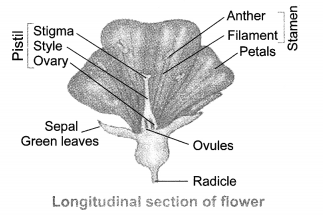
Question 8
What are the different methods of contraception ?
Answer:
The different methods of contraception are as follow :
(i) Barrier method : In this method, condom, diaphragm and cervical caps are used. These prevent the entry of sperms in the female genital tract during sexual intercourse.
(ii) Chemical method : In this method a woman uses two kinds of pills (oral and vaginal pills). The oral pills are hormonal preparations which suppress the release of ovum in fallopian tube. These are called oral contraceptives. The vaginal pills/ creams are spermicidal. The chemicals in these spermicidals kill the sperms during their journey in the vaginal tract.
(iii) Intrauterine contraceptive devices : Intrauterine contraceptive devices such as copper-T are placed safely in the uterus by a skilled doctor. It prevents the sperms to reach the uterus.
(iv) Surgical method : In this method, a small part of vas deferens of male and fallopian tube of female is cut or tied by surgery. It is called vasectomy in males and tubectomy in females.
Question 9
How are the modes for reproduction different in unicellular and multicellular organisms ?
Answer:
| Reproduction mode in unicellular organisms | Reproduction mode in multicellular organisms |
| (i) A sexual reproduction takes place in unicellular organisms. | (i) Sexual reproduction takes place in multicellular organisms. |
| (ii) Only one organism is required in this method. | (ii) A male and a female both are required in this method. |
| (iii) No special cells are present for reproduction. | (iii) Special cells are present for reproduction. |
| (iv) No special organs are present for reproduction. | (iv) Special organs are present for reproduction located at the fixed position in the body. |
Question 10
How does reproduction help in providing stability to populations of species ?
Answer:
The introduction of variations during reproduction provides stability to the populations of various species by preventing them from getting wiped out during adverse conditions. Reproduction also helps to generate copies of individuals which are suited to a particular environment.
Question 11
What could be the reasons for adopting contraceptive methods ?
Answer:
The reasons for adopting contraceptive devices are as follow:
- To control the birth rate and prevent the increase in population.
- To reduce the adverse effects on mother’s body due to frequent pregnancy.
- To provide safety from sexually transmitted diseases.
NCERT Solutions for Class 10 Science Chapter 8 How Do Organisms Reproduce?
Reproduction: Reproduction in animals and plants (asexual) and (sexual) reproductive health – need and methods of family planning. Safe sex vs HIV/ AIDS. Child bearing and women’s health.
| Board | CBSE |
| Textbook | NCERT |
| Class | Class 10 |
| Subject | Science |
| Chapter | Chapter 8 |
| Chapter Name | How Do Organisms Reproduce? |
| Number of Questions Solved | 26 |
| Category | NCERT Solutions |
Formulae Handbook for Class 10 Maths and Science
Page 128
Question 1.
What is the importance of DNA copying in reproduction?
Answer:
DNA copying in reproduction is important for maintenance of body designs and features. Moreover, DNA copying leads to variations. Variation is useful for the survival of species.
Question 2.
Why is variation beneficial to the species but not necessarily for the individual?
Answer:
Population of organisms reside in well-defined places or niches in the ecosystem. However, niches can change because of reasons beyond the control of the organisms, e.g., temperature changes, water level changes, etc. If population of reproducing organisms suited to particular niche and if the niche is drastically altered, the population can be wiped out. However, if some variations are present in a few inAividuals in these populations, there will be chances for their survival. The surviving individual can further reproduce and develop a population according to the changed niche, Thus, variation is beneficial to the species but not necessarily for the individual.
Page 133:
Question 1.
How does binary fission differ from multiple fission ?
Answer:
When two new daughter cells are formed as a result of fission. It is called binary fission, e.g., Amoeba.When many daughter cells are formed as a result of fission, this is called multiple fission, e.g., Malarial parasite.
Question 2.
How will an organism be benefited if it reproduces through spores?
Answer:
Spore formation is an asexual mode of reproduction. Spores formed are covered by
thick walls that protect them from adverse conditions. During favourable condition thick resistant wall breaks down and new organism grows from it.
Spores are very light weight and they easily get dispersed through winds which give them more variations and thus better chances of survival.
Question 3.
Can you think of reasons why more complex organisms cannot give rise to new individuals through regeneration?
Answer:
Complex organisms are not simply a random collection of cells where sPecialized cells are organised as tissues, and tissues ale organised into organs which then have to be placed at definite positions in the body. In such a carefully organised situation, it is not easy to develoP organism through regeneration
Question 4.
Why is vegetative propagation practised for growing some type of plants?
Answer:
Vegetative propagation makes possible for the propagation of plants such as banana, orange, rose and jasmine that have lo6t the capacity to Produce seeds. Moreover, all plants produced through vegetative propagation are genetically similar to the parent plant.
Question 5.
Why is DNA copying an essential part of the process of reproduction?
Answer:
The process of reproduction results in the production of off springs which resemble to their parents. This means during the reproduction there must be a transfer of the blueprint of the body design from parent to the off springs. As we know DNA contains all the information that passes from parents to the next generation, so before reproduction, DNA is copied in the parent cell. Out of these two copies, one copy is passed to the newly formed individual.
Page 140
Question 1.
How is the process Of pollination different from fertilization ?
Answer:
Pollination is the transfer of pollen grains from the anther to the stigma Of a flower whereas fertilization is the fusion Of male gamete with female gamete (egg).
Question 2.
What is the role of the seminal vesicles and the prostate gland ?
Answer:
Seminal vesicles and the prostate gland add their secretions so that the sperms are in a fluid (semen) which makes their transport easier and this fluid also provides nutrition.
Question 3.
What are the changes seen in girls at the time Of puberty ?
Answer:
Changes seen in girls at the time of puberty are :
1. Breast size begins to increase.
2. Girls begin to menstruate.
3.Growth Of pubic hair.
4.Skin becomes oily.
Question 4.
How does the embryo get nourishment inside the Mother’s body?
Answer:
embryo gets nutrition from mother’s blood with the help Of a special tissue called placenta. Through placenta, glucose and oxygen pass from mother to the embryo. Moreover, waste substance of embryo are removed through placenta into the
mother’s blood.
Question 5.
If a woman is using a copper-T will it help in protecting her from sexually transmitted diseases?
Answer:
No, copper-Twill not protect her from Only Barrier methods protect from sexually transmitted diseases.
Page 141
Question 1.
Asexual reproduction takes place through budding in :
(a) Amoeba
(b) Yeast
(c) Plasmodium
(d) Leishmania.
Answer:
(b) Yeast.
Question 2.
Which of the following is not a pan Of the female reproductive system in human beings ?
(a) Ovary
(b) Uterus
(c) Vas deferens
(d) Fallopian tube
Answer:
(c) Vas deferens.
Question 3.
The anther contains :
(a) Sepals
(b) Ovules
(c) Carpel
(d) Pollen grains.
Answer:
(d) Pollen grains
Question 4.
What are the advantages of sexual reproduction over asexual reproduction?
Answer:
Sexual reproduction leads to new combination Of genes as it involves two parents and meiosis. This produces variation in offspring. Variations are the basis for evolution.
Question 5.
What are the functions performed by the testes in human beings?
Answer:
Functions Of testes are .
(i) Testes produce sperms.
(ii) Testosterone (male sex hormone) is also produced by testes.
Question 6.
Why does menstruation occur?
Answer:
If the egg is not fertilized and uterus does not get zygote, the developed lining slowly breaks and menstruation occur.
Question 7.
What are the different methods of contraception?
Answer:
There are three main methods of contraception :
- Barrier methods,
- Chemical methods, and
- Surgical methods.
1. Barrier methods: In barrier methods, physical devices such as condom, diaphragm and cervical caps are used. They prevent the entry Of sperms in the female genital tract during copulation.
2. Chemical methods: The chemical methods make use of specific drugs by females. There are two types of such drugs, Oral pills and vaginal pills. Oral pills are mainly hormonal preparation, and are called oral contraceptives (OCS).
3. Surgical methods: In the surgical methods, a small portion of vas deferens in male, and the fallopian tube in female, in surgically removed or ligated (tied). It is called vasectomy in males and tubectomy in females.
Apart from these three methods the intrauterine contraceptive devices are used to prevent pregnancies. The use of Intra Uterine Contraceptive Devices (IUCDs) is also very effective and popular. A copper-T is placed safely inside the uterus by a practising doctor or a skilled nurse. IUCDs prevent implantation in the uterus.
Question 8.
How are the modes for reproduction different in unicellular and multicellular organisms ?
Answer:
Unicellular organisms reproduce asexually whereas multicellular organisms reproduce manly by n 1 reproduction.
Question 9.
How does reproduction help in providing stability to populations Of species?
Answer:
The rate Of birth and death in a given population determine its stability. The rate of birth should be approximately equal to the rate of death. So, by checking birth rate, which is increasing at an alarming rate, stability to population of species can be provided
Question 10.
What could be the reasons for adopting contraceptive methods?
Answer:
Frequent pregnancies have an adverse effect on the health of a woman. Frequent and unwanted pregnancies can be avoided by adopting contraceptive methods. Also, these methods check population growth by controlling child birth rate.
Multiple Choice Questions (MCQs) [1 Mark each]
Question 1.
Asexual reproduction takes place through budding in [NCERT]
(a) Amoeba
(b) Yeast
(c) Plasmodium
(d) Leishmania
Answer:
(b) Asexual reproduction in Hydra and yeast takes place by budding.
Question 2.
The ability of a cell to divide into several cells during reproduction in Plasmodium is called [NCERT Exemplar]
(a) budding
(b) reduction division
(c) binary fission
(d) multiple fission
Answer:
(d) Multiple fission Organisms divide into many daughter cells simultaneously, e.g. Plasmodium.
Question 3.
The anther contains [NCERT]
(a) sepals
(b) ovules
(c) carpels
(d) pollen grains
Answer:
(d) Anther is the male reproductive part in plants. It contains pollen grains, having male germ cells.
Question 4.
Characters that are transmitted from parents to offspring during reproduction show [NCERT Exemplar]
(a) only similarities with parents
(b) only variations with parents
(c) both similarities and variations with parents
(d) neither similarities nor variations
Answer:
(c) In sexual reproduction, the offsprings are not exactly identical to the parents or to one another. This is because the offsprings receive some genes from mother and some from father. Because of mixing of genes on re-establishment of the exact number of chromosomes as in the parents, the offsprings show both similarities and variations with their parents.
Question 5.
Which among the following diseases is not sexually transmitted? [NCERT Exemplar]
(a) Syphilis
b) Hepatitis
(c) HIV-AIDS
(d) Gonorrhoea
Answer:
(b) The diseases, which are spread by sexual contact with an infected person are called Sexually Transmitted Diseases or STDs, e.g. gonorrhoea, syphilis and AIDS. Hepatitis is a water borne viral disease which affects liver.
Question 6.
Which of the following is not a part of the female reproductive system in human beings? [NCERT]
(a) Ovary
(b) Uterus
(c) Vas deferens
(d) Fallopian tube
Answer:
(c) Vas deferens is a part of male reproductive system in humans.
Question 7.
A feature of reproduction that is common to Amoeba, Spirogyra and yeast is that [NCERT Exemplar]
(a) they reproduce asexualiy
(b) they are all unicellular
(c) they reproduce only sexually
(d) they are all multicellular
Answer:
(a) Amoeba and yeast are unicellular while Spirogyra is multicellular. But, all the three reproduce asexualiy.
Question 8.
Which among the following statements are true for unisexual flowers? [NCERT Exemplar]
I. They possess both stamen and pistil.
II. They possess either stamen or pistil.
III. They exhibit cross-pollination.
IV. Unisexual flowers possessing only stamens cannot produce fruits.
(a) I and IV
(b) II, III and IV
(c) III and IV
(d) I, III and IV
Answer:
(b) The flowers which are unisexual (papaya, watermelon) contain either stamens or carpels. Since, only one reproductive organ is present in them, they depend on cross-pollination to form zygote after fertilisation. Both stamens and carpels are required for fertilisation, so only one of them cannot produce fruits.
Question 9.
Length of pollen tube depends on the distance between [NCERT Exemplar]
(a) pollen grain and upper surface of stigma.
(b) pollen grain on upper surface of stigma and ovule.
(c) pollen grain in anther and upper surface of stigma.
(d) upper surface of stigma and lower part of style.
Answer:
(b) Length of pollen tube depends on the distance between pollen grain on upper surface of stigma and ovule. A pollen grain falls on the stigma of the carpel, bursts open and develops a pollen tube downwards through the style towards the ovule in the ovary.
Question 10.
Which among the following statements arer true for sexual reproduction in flowering plants? [NCERT Exemplar]
I. It requires two types of gametes.
II. Fertilisation is a compulsory event.
III. It always results in formation of zygote.
IV. Offsprings formed are clones.
(a) I and IV
(b) I and II
(c) I, II and III
(d) I, II and IV
Answer:
(c) Sexual reproduction creates variation in organisms, so, clones cannot be produced through it. Clones are identical copy of parent organism. Sexual reproduction needs two type of gametes, i.e. male and female to form zygote after fertilisation.
Question 11.
Factors responsible for the rapid spread of bread mould on slices of bread are [NCERT Exemplar]
I. large number of spores.
II. availability of moisture and nutrients in bread.
III. presence of tubular branched hyphae.
IV formation of round-shaped sporangia
(a) I and III
(b) II and IV
(c) I and II
(d) III and IV
Answer:
(c) Under favourable Conditions (like damp and warm conditions, availability of nutrients), the fungal spores present in the air, lands on food, germinate and produce new plaints.
Question 12.
During adolescence various changes occur in the body of humans. Mark one change associated with sexual maturation in males. [NCERT Exemplar]
(a) Loss of milk teeth
(b) Increase in body height
(c) Cracking of voice
(d) Weight gain
Answer:
(c) Hypertrophy of larynx results in low pitched. cracking voice in human males during adolescence.
Question 13.
Observe the diagram given along side.
What happens after the above stage?
(a) The ovary splits open
(b) Ovary develops into a fruit and ovules into seeds
(c) The pvules are dispersed
(d) Germination of seeds takes place
Answer:
(b) Ovary develops into a fruit and ovulesdnto seeds as in the above given diagram fertilisation has already taken place.
Question 14.
What in your opinion could be the best reason to explain why menstruation is not taking place in a healthy woman?
(a) Early release of ovum
(b) Psychological reason
(c) Fertilisation of ovum
(d) Build up of female sex hormones in the blood stream
Answer:
(c) If a woman is not having her menstruation on time the probable reason from the given option is that fertilisation of ovum has taken place. Because, during gestation period of pregnancy, menstruation does not take place.
Question 15.
The correct sequence of reproductive stages seen in flowering plants is [NCERT Exemplar]
(a) gametes, zygote, embryo, seedling
(b) zygote, gametes, embryo, seedling
(c) seedling, embryo, zygote, gametes
(d) gametes, embryo, zygote, seedling
Answer:
(a) Correct sequence of reproductive stages in flowering plants is → formation of gametes → fusion of gametes to form zygote → zygote develops into embryo in the ovary → ovule develops a tough coat and converts into a seed.
Question 16.
Offsprings formed by asexual method of reproduction have greater similarity among themselves because [NCERT Exemplar]
I. asexual reproduction involves only one parent.
II. asexual reproduction does not involve gametes.
III. asexual reproduction occurs before sexual reproduction.
IV. asexual reproduction occurs after sexual reproduction.
(a) I and II
(b) I and III
(c) II and IV
(d) III and IV
Answer:
(a) Offsprings have greater similarity as only one parent is involved in asexual reproduction thus, no gametes are formed.
Question 17.
Two flowers are identified by a botanist with the following features that flower A is having only stamen and flower B is having both stamen and pistil. Which of the following statements is correct?
(a) Flower A will bear seeds and flower B cannot bear seeds after fertilisation.
(b) Flower A will produce pollen grains and flower B cannot produce pollen grains.
(c) Flower A cannot be fertilised and flower B can show fertilisation.
(d) Neither flower A and nor flower B can show self-pollination.
Answer:
Option (c) is correct. Since, flower A bears only stamen, i.e. male reproductive part so, it cannot get fertilised. And flower B bears both male and female reproductive parts, therefore it can get fertilised by pollination and can change into fruit.
NCERT Solutions for Class 10 Science Chapter 8 How do Organisms Reproduce (Hindi Medium)
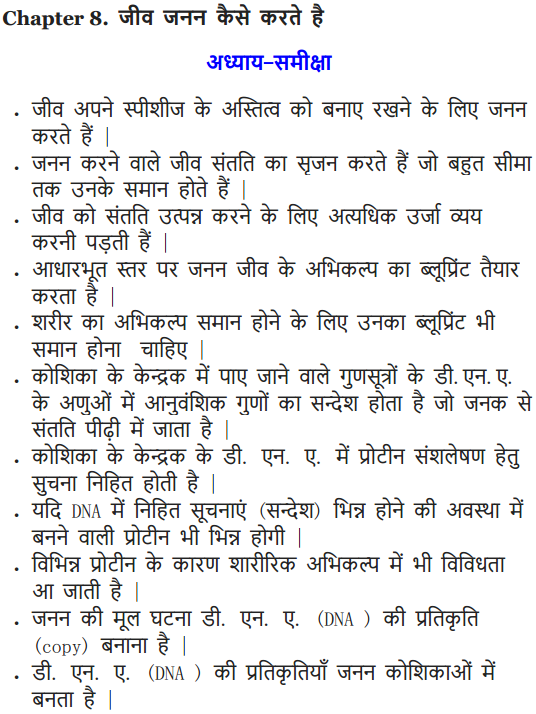
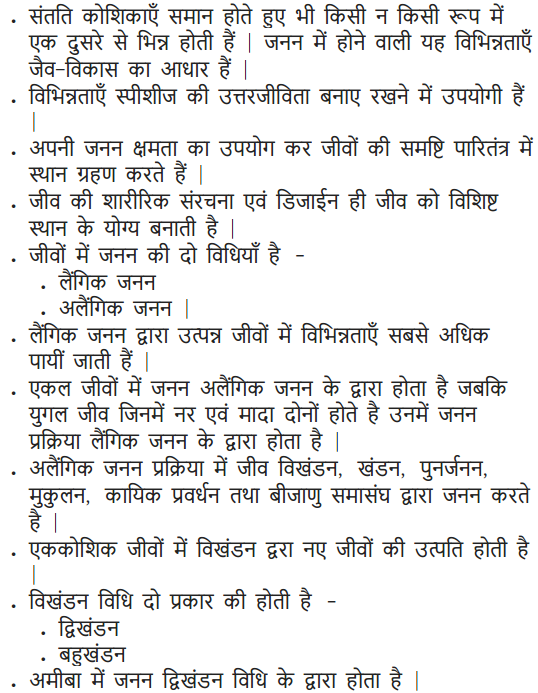
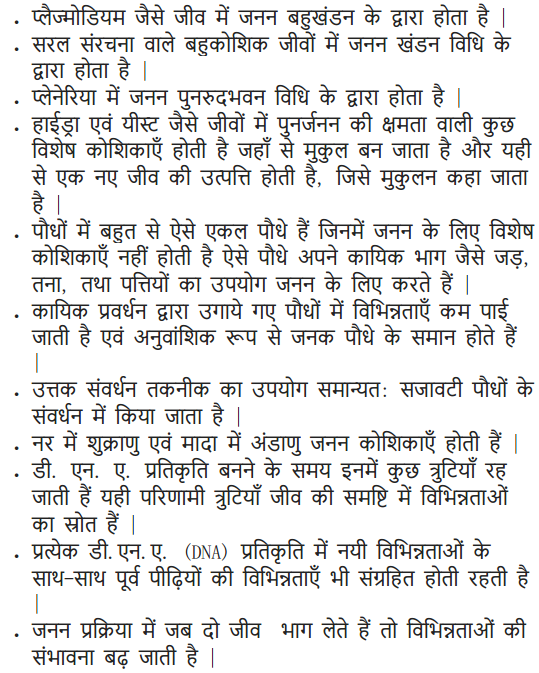
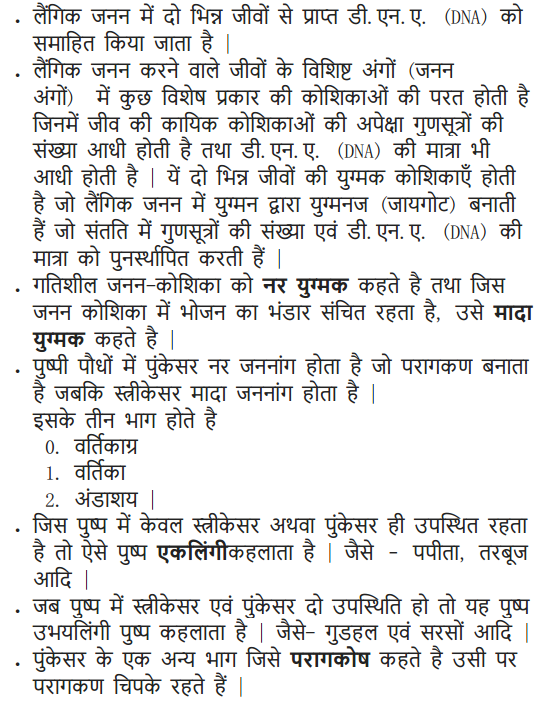
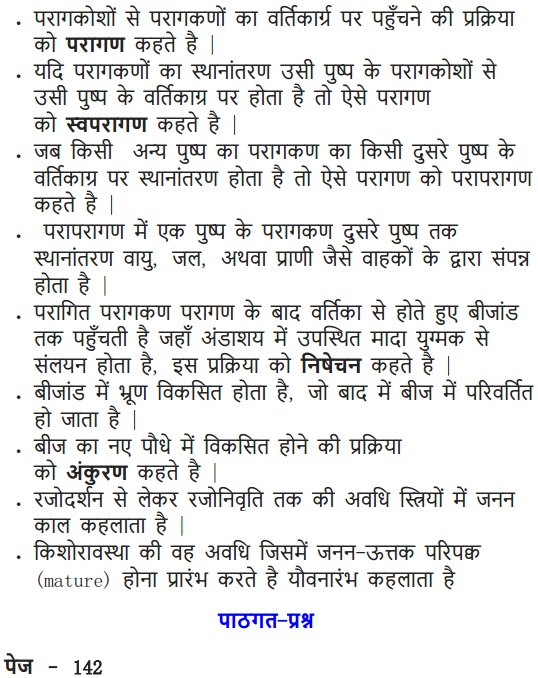
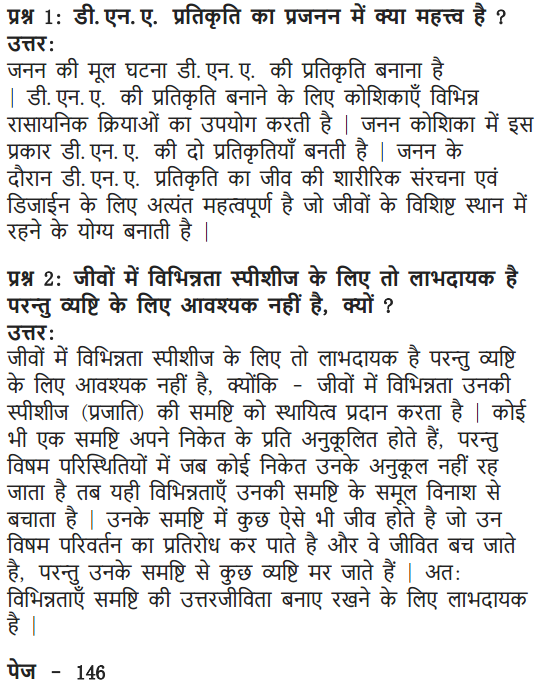
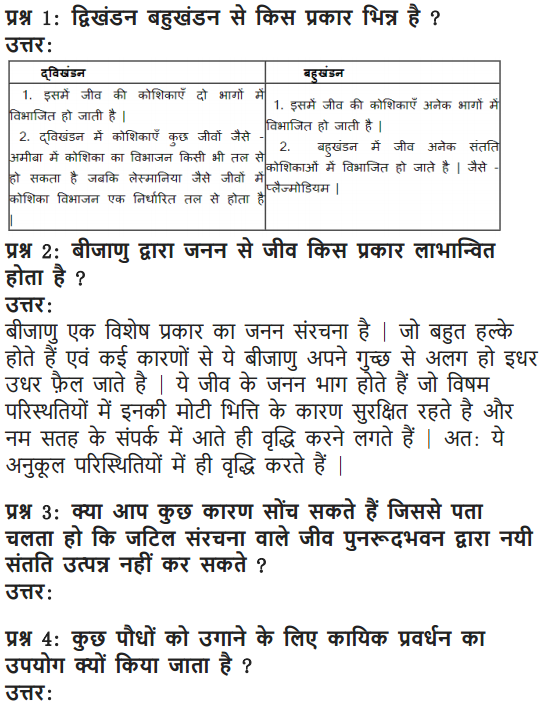
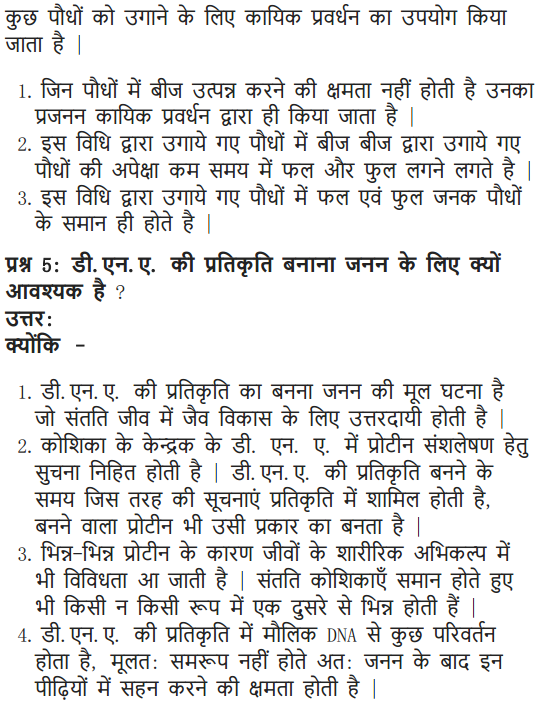
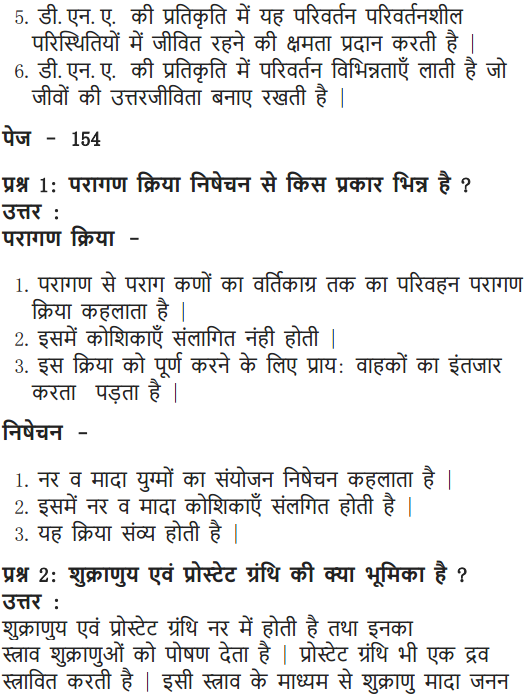
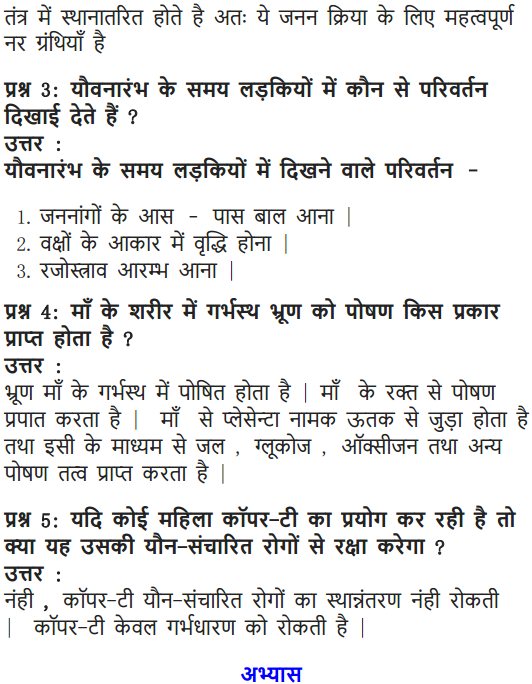
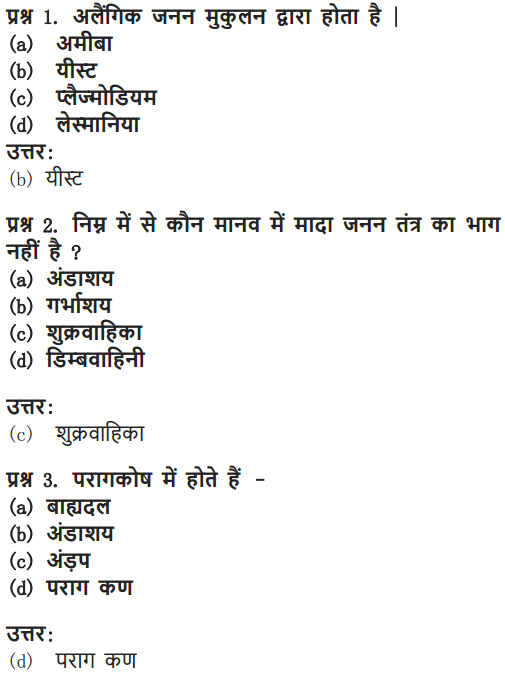
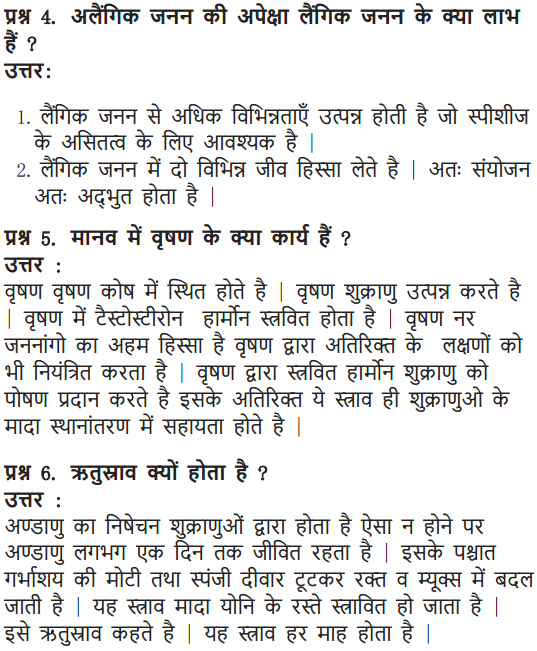
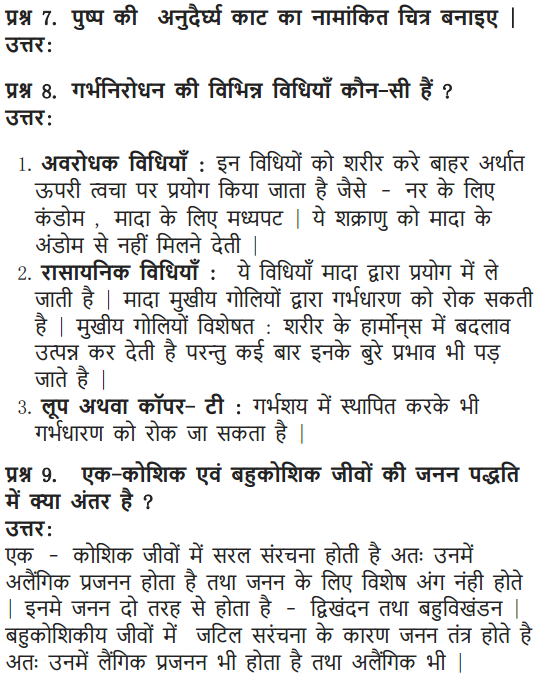
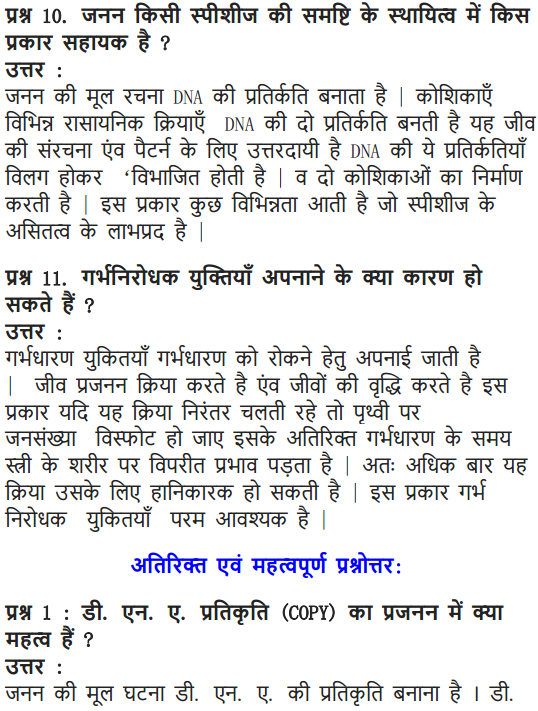
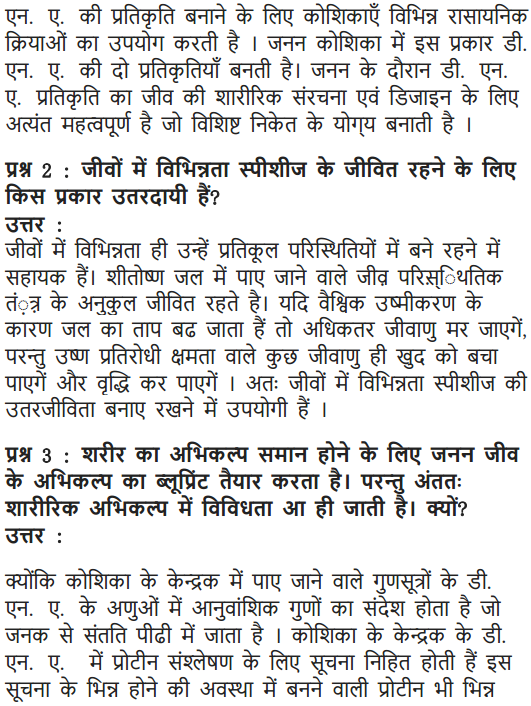
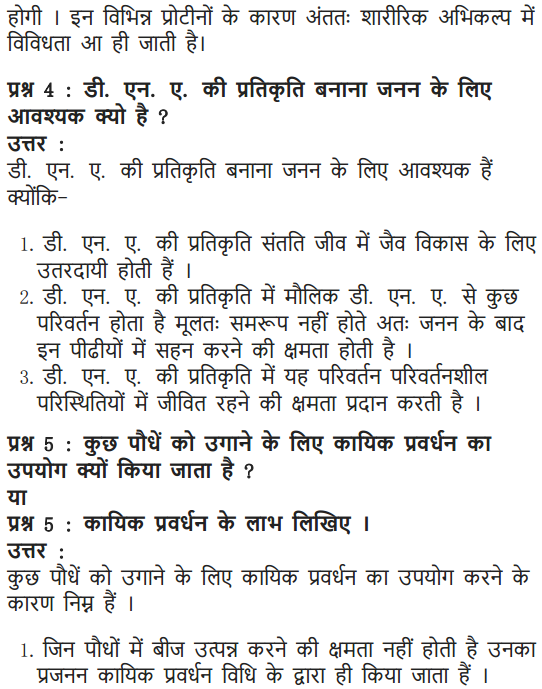
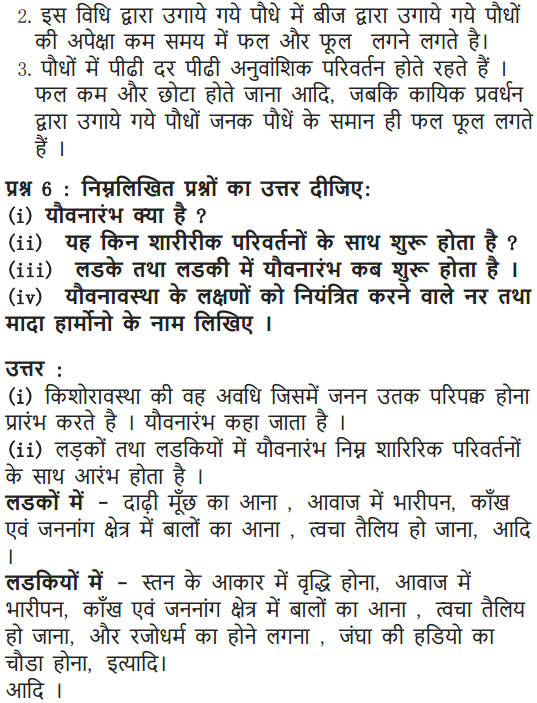
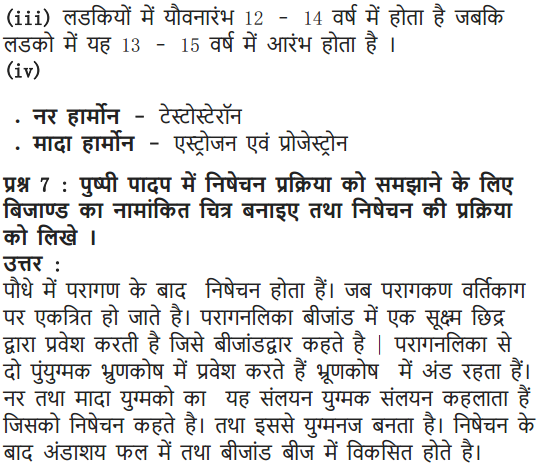
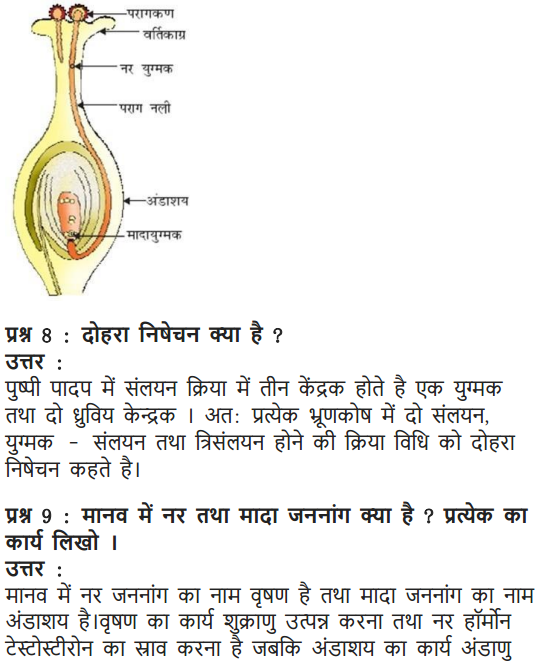
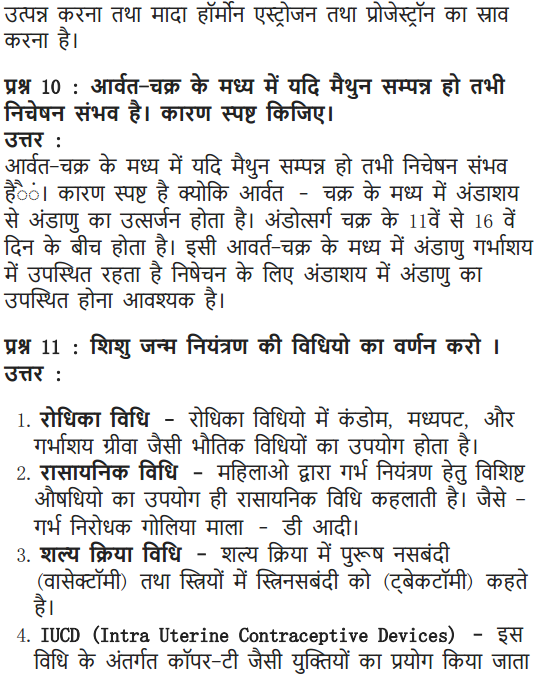
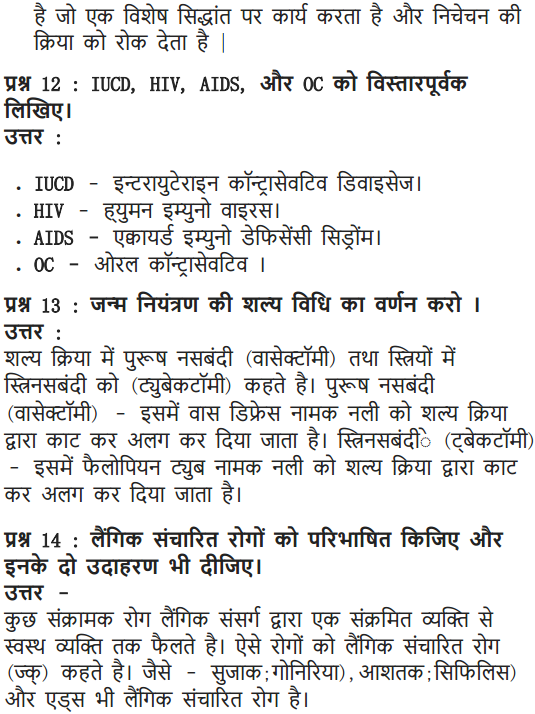
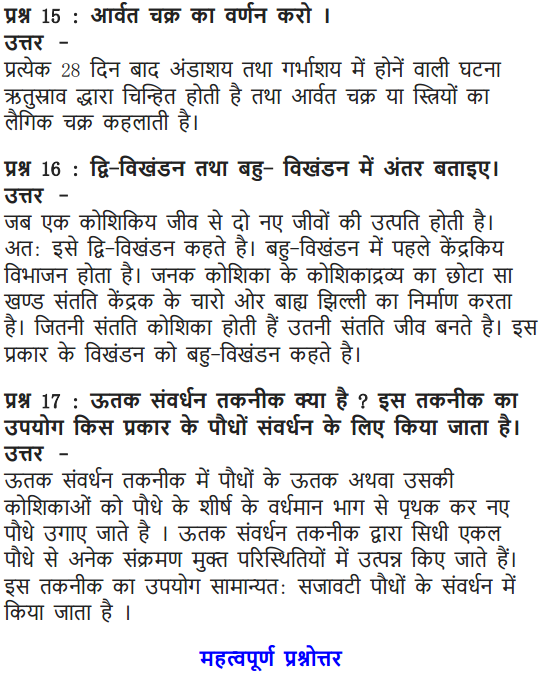
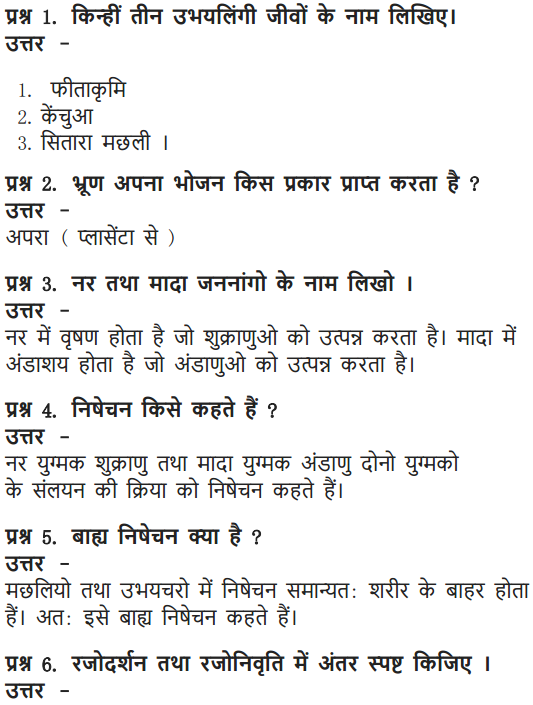
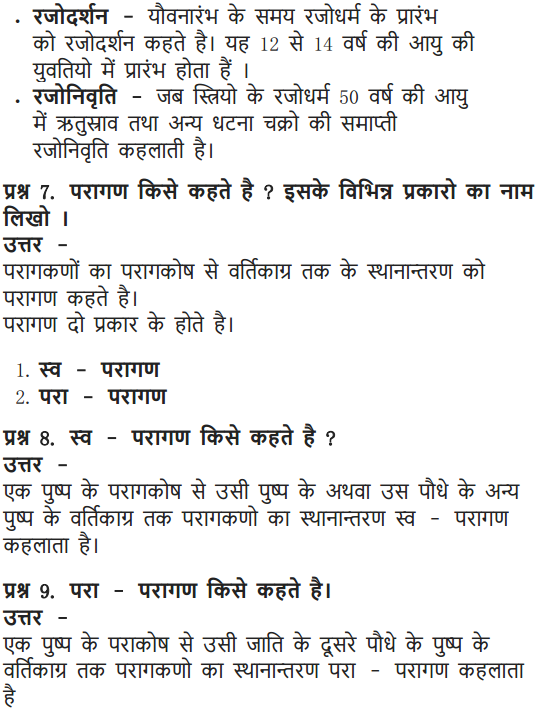
Class 10 Science How Do Organisms Reproduce Mind Map
- Reproduction is a biological process in which an organism gives rise to young ones similar to themselves.
- Basic event in reproduction is the creation of a DN A copy.
- Cells use chemical reactions to build two copies of the DNA in a reproducing cell.
- In addition, DNA copying is accompanied by the creation of an additional cellular apparatus.
- Then each DNA copy is separated with its own cellular apparatus.
- Effectively, a cell divides to give rise to two cells.
Asexual Reproduction
When offspring is produced by single parent with or without the involvement of gamete formation.
Fragmentation
- Parent organism breaks into smaller fragments upon maturation, each fragment grows into a new individual.
- It is shown by multi-cellular organisms with simple body organization for e.g. Spirogyra
Fission
- Organisms divide mitotically into two halves, each behaves like independent individual. It is termed as binary fission and is mostly shown by bacteria and protozoa.
- Binary fission can take place in any plane as observed in Amoeba, or it can occur in a definite orientation for e.g. Leishmania (causes kala-azar), Euglena (longitudinal), Paramecium (transverse) etc.
- In few organisms parent cell divides into many daughter cells simultaneously which is termed as multiple fission. It is observed in Plasmodium.
Budding
- Formation of daughter organism takes place from a small projection called as bud. For e.g. Hydra, Yeast etc
- Organisms such as Hydra use regenerative cells for reproduction in the process of budding.
- Repeated cell division at one specific site leads to the formation of an outgrowth called as bud.
- These buds develop into tiny individuals and detach form parent body once they become fully mature.
- Detached organism acts as an independent organism.
Regeneration
- It is an ability of simple organisms to re-grow their lost body parts.
- In asexual reproduction, this ability is used by many organisms to give rise to new individual from their body parts. That is, if the individual is somehow’ cut or broken up into many pieces, many of these pieces grow into separate individuals.
- For e.g. Hydra and Planaria
- It is carried out by specialized cells which proliferate & differentiate to make various cell types tissues.
- These changes take place in an organized sequence referred to as development.
- However, regeneration is not the same as reproduction, since most organisms would not normally depend on being cut up to be able to reproduce.
Spore Formation
- An individual divides into no. of small spores, each spore giving rise to new individual.
- Spores are covered by thick walls that protect them until they come into contact with moist surface or suitable environment and can begin to grow. E.g. Spore formation in Rhizopus
Vegetative Propagation
- It refers to the formation of new plants from parts of parent plants such as root, stem, leave etc. These parts are termed as vegetative units or vegetative propagules. For e.g. buds produced in the notches along the leaf margin of Bryophyllum fall on the soil and develop into new plants
- Advantages of vegetative propagation:
- Vegetative propagation is used in methods such as layering, cutting, grafting to grow many plants like sugarcane, roses, or grapes for agricultural purposes.
- Plants raised by vegetative propagation can bear flowers and fruits earlier than those produced from seeds.
- It makes it possible to propagate plants that have lost the capacity to produce seeds such as banana, orange, rose and jasmine.
- Plants produced are genetically similar enough to the parent plant to have all its characteristics.
Sexual Reproduction
It involves the formation and fusion of the gametes. It leads to formation of variations in individuals. Variations form the basis of evolution of the species and ensure the survival of the species.
Reproduction in Human Beings
Puberty: The period during which adolescents reach sexual maturity and become capable of reproduction.
- Changes in girls during puberty: breast size begins to increase, darkening of skin of nipples, & girls begin to menstruate.
- Changes in boy during puberty: hair growth on face, voices begin to crack & occasional erection & enlargement of penis
- Changes common to both boys & girls: hair growth in various parts such as armpits, genital area, thin hairs on arms & legs and skin may become oily.
Female Reproductive System
- It consists of a pair of ovaries, pair of oviduct (fallopian tube), uterus, cervix, & vagina.
- One egg is produced every month by one of the ovaries after reaching the age of puberty. The egg is carried from the ovary to the womb through a thin oviduct or fallopian tube.
- Uterus serves as womb and is richly supplied with blood vessels to nurture the developing embryo.
- Vagina serves as the site of entry of sperm during sexual intercourse.
Male Reproductive System
- It consists of a pair of testes located outside the body in a pouch called scrotum. It helps in maintaining lower temperature which favors the perm formation. Testes are responsible for synthesizing sperms and testosterone.
- Sperms are tiny bodies consists of mainly genetic material and a tail that helps them to move towards the female germ-cell.
- Sperms are then delivered through vas deferens which unites with urethra to form a common passage for sperm and urine.
- Accessory glands like seminal vesicles, prostate, and bulbourethral add their secretion to sperm. It makes the sperm fluid in nature that not only eases the transportation of sperm but also provide the nutrition to it.
Reproductive Health
- Sexually transmitted diseases include bacterial infections (gonorrhea, syphilis etc) & viral infections (warts, AIDS etc).
- Contraception refers to the act of preventing the unwanted pregnancies. Contraceptive methods may fall in following categories:
- Mechanical barrier: e.g. condom, diaphragms. They also prevent STDs.
- Oral contraceptives: they change hormonal balance, inhibits ovulation & thus fertilization e.g. saheli, iPill, etc.
- Intra uterine device: plastic or metal devices placed in the uterus for e.g. loop, copper-T etc.
- Surgical methods such as vasectomy & tubectomey.
Events of Reproduction
- The sperms after entering the vaginal passage travel upwards and reach the oviduct where they may fertilize the egg.
- Post-fertilization, the zygote gets implanted in the lining of the uterus, and starts dividing.
- Special tissue called placenta is developed to provide nutrition to the developing embryo as well as for removing waste from it.
- The development of a child takes up approx, nine months.
- The child is born as a result of rhythmic contractions of the muscles in the uterus.
Menstruation
Menstrual cycle is a cyclic event that places roughly every month in females after puberty. Unfertilized egg lives for 1 day after which it degenerates. Consequently, uterus lining slowly breaks & comes out through the vagina as blood & mucus. This discharge is known as menstruation which lasts for about 2-8 days.
Sexual Reproduction in Flowering Plants
• Stamens and carpels are the reproductive parts of a flower which contain the germ-cells. Stamen is the male reproductive part and it produces pollen grains. Carpel is the female reproductive part made up of three parts: ovary, style and stigma.
• The ovary contains ovules and each ovule has an egg cell.
• The flower may be unisexual i.e. contains either stamens or carpels e.g. papaya, watermelon or bisexual i.e. contains both stamens and carpels e.g. Hibiscus, mustard.
• Transfer of pollen grains (shed from the anther) to the stigma of a pistil is termed pollination. Two types: self-pollination and cross pollination. Pollinating agents are air, water, insects, & animals.
• Compatible pollen grain germinates on stigma to produce pollen tube. Pollen tube grows through tissues of stigma, style & reaches ovary.
• Fertilization results in the formation of zygote which develops into an embryo.
• The ovule develops a tough coat and is gradually converted into a seed. The ovary grows rapidly and ripens to form a fruit.
• The petals, sepals, stamens, style and stigma may shrivel and fall off.
• The seed develops into a seedling under appropriate conditions which is known as germination.
We hope this detailed article on NCERT Solutions For Class 10 Science Chapter 8 How Do Organisms Reproduce? helps you. If you have any query regarding the how do organisms reproduce class 10 notes NCERT solutions, drop it in the comment section below and we will get back to you.
Important Questions of How Do Organisms Reproduce Class 10 Science Chapter 8
Question 1.
Newly formed DNA copies may not be identical at times. Give one reason. (AI2017)
Answer:
When a cell reproduces, DNA replication occurs which results in formation of two similar copies of DNA. The process of copying the DNA leads to some variations each time. As a result, the DNA copies produced are similar to each other but sometimes may not identical.
Question 2.
When a cell reproduces, what happens to its DNA? (AI 2017)
Answer:
When a cell reproduces, DNA replication occurs which forms two similar copies of DNA..
Question 3.
What is DNA? (Delhi 2016, Foreign 2015)
Answer:
DNA (deoxyribonucleic acid) is a polymer made up of large number of nucleotide units. It carries genetic information from generation to generation.
Question 4.
Name the life process of an organism that helps in the growth of its population. (AI 2015)
Answer:
Reproduction is a life process that helps in multiplication of an organism and growth of its population.
Question 5.
Reproduction is one of the most important characteristic ‘of living beings. Give three reasons in support of the statement. (AI 2017)
Answer:
Reproduction is one of the most important characteristics of living beings because :
- it is essential for existence and continuity of a species.
- it helps to pass genetic information to next generation.
- it brings variations in next generation which is the basis for evolution.
Question 6.
Define reproduction. How does it helps in providing stability to the population of species? (AI 2016)
Answer:
The production of new organisms by the existing organisms of the same species is known as reproduction. It is linked to the stability of population of a species. DNA replication during reproduction ensures transfer of specific characters or body design features that is essential for an individual of a population to live and use that particular niche. Some variations present in a few individuals of population caused due to reproduction which also helps in their survival at changing niches.
Question 7.
What is DNA copying? State its importance. (Delhi 2015)
Answer:
DNA copying is the production of similar copies of DNA present in a cell using various chemical reactions. DNA copying is essential for reproduction through which the organisms pass on their body features to their offspring. Moreover, minor alternations during the process of DNA copying result in the production of variations. Such variations are useful for the survival of species over time.
Question 8.
What is the effect of DNA copying, which is not perfectly accurate, on the reproduction process? How does the amount of DNA remain constant through each new generation is a combination of DNA copies of two individuals? (AI 2014)
Answer:
In the process of reproduction, if DNA copying is not perfectly accurate, variation occurs. These in turn may allow few individuals of a population to survive in an altered niche and becomes the basis of evolution and over time. Such variations are useful for the survival of species.
The combination of DNA copies of two individuals, (male and female) occurs during sexual reproduction. Reduction division (meiosis) during gamete formation halves the chromosome number in both male and female gametes. Since these two gametes fuse during fertilisation, the original number of chromosomes (as in the parent) is restored in the offspring. By this way the amount of DNA remains constant in each new generation.
Question 9.
Name the method by which Spirogyra reproduces under favourable conditions. Is this method sexual or asexual? (Delhi 2017)
Answer:
The method by which Spirogyra reproduces under favorable conditions is fragmentation. This is an asexual mode of reproduction.
Question 10.
How does Plasmodium reproduce. Is this method sexual or asexual? (Delhi 2017)
Answer:
Plasmodium reproduces through multiple fission method. In this method, the parent organism splits to form many new organisms at the same time. This is an asexual method of reproduction.
Question 11.
Name the part of Bryophyllum where the buds are produced for vegetative propagation. (Delhi 2016)
Answer:
Bryophyllum propagates vegetatively by the buds produced at the margins of leaves.
Question 12.
What happens when a Planaria gets cut into two pieces? (Delhi 2016)
Answer:
When Planaria is cut into two pieces then each piece grows into a complete organism. This is known as regeneration.
Question 13.
What happens when a mature Spirogyra filament attains considerable length? (AI 2016)
Answer:
When a mature Spirogyra filament attains considerable length it simply breaks into two or more fragments and each fragment then grows into a new Spirogyra.
Question 14.
Name the method by which Hydra reproduces. Is this method sexual or asexual ? (Foreign 2016)
Answer:
Hydra generally reproduces through budding. It is an asexual method of reproduction.
Question 15.
Name two simple organisms having the ability of regeneration. (AI 2015)
Answer:
Hydra and Planaria are two organisms that have the ability to regenerate.
Question 16.
Name the causative agent of the disease “kala- azar” and its mode of asexual reproduction. (Foreign 2015)
Answer:
Causative agent of the disease Kala-azar is Leishmania. It reproduces asexually by binary fission.
Question 17.
Write two differences between binary fission and multiple fission in a tabular form. (Delhi 2015)
Answer:
Differences between binary fission and multiple fission are as follows:
| Binary fission | Multiple fission |
| (i) The parent organism, splits to form two new organisms, e.g., Amoeba, Paramecium. | The parent organism splits to form many new organisms at the same time, e.g., Plasmodium. |
| (ii) The nucleus of the parent body divides only once to produce two nuclei. | The nucleus of the parent body divides repeatedly to produce many nuclei. |
Question 18.
List four modes of asexual reproduction other than fission in the living organisms. (Delhi 2014)
Answer:
The four modes of asexual reproduction other than fission in living organisms are :
- budding
- spore formation
- regeneration and
- fragmentation.
Question 19.
List four advantages of vegetative propagation. (Delhi 2014)
Answer:
The following are the advantages of vegetative propagation:
- The characters of the parent plants are preserved hence a good variety produced can be propagated by vegetative means.
- The plants, which do not produce viable seeds or produce very few seeds, can be reproduced by this method. For example, banana, potato, grapes, sugarcane, rose, orange, etc.
- It is an easier, quicker and cheaper method of propagation.
- It is easier to get rid of pathogen from any part of plant by vegetative propagation.
Question 20.
List four modes of asexual reproduction. (Delhi 2014)
Answer:
The four modes of asexual reproduction are :
- binary fission
- budding
- regeneration and
- vegetative propagation.
Question 21.
Draw labelled diagrams to illustrate budding in Hydra. (AI 2014)
Answer:
The given diagram illustrates budding in Hydra:
Question 22.
How do Plasmodium and Leishmania reproduce? Write one difference in their mode of reproduction. (Foreign 2014)
Answer:
Plasmodium and Leishmania reproduce by the process of fission which is an asexual mode of reproduction. Plasmodium reproduces by multiple fission. About 1000 daughter cells are produced by the multiple fission of a Plasmodium. Leishmania reproduces by the process of binary fission. In Leishmania, the splitting of parent cell takes place in a definite plane (longitudinally) with respect to flagellum at its end to produce two daughter cells.
Question 23.
Define multiple fission. Give its one example. (Foreign 2014)
Answer:
Multiple fission is an asexual mode of reproduction in which the parent organism splits to form many new organisms at the same time. Multiple fission occurs in Plasmodium.
Question 24.
List two advantages ofvegetative reproduction practised in case of an orange plant. (Delhi 2012)
Answer:
The two advantages of vegetative propagation practised in case of an orange plant are :
- The new plants produced by vegetative propagation will be exactly like the parent plant. Therefore, any desirable features of the parent plant will be replicated in the new plants.
- The orange plants that have lost the capacity to produce seeds, can also be propagated.
Question 25.
Name an organism which reproduces by spore formation. List three conditions favourable for spores to germinate and grow. (AI 2012)
Answer:
Rhizopus reproduce by the method of spore formation.
The three conditions favourable for spores to germinate and grow are moisture, suitable temperature and food (nutrition).
Question 26.
List two advantages of practising vegetative propagation in plants. Select two plants raised by this method from the list given below : Banana, Gram, Pea, Rose, Tomato, Wheat (Foreign 2012)
Answer:
Two advantages of the vegetative propagation of plants are:
- Any desirable features of the parent plant can be replicated in the new plants.
- Flowers and fruits can be grown in a shorter time as compared to the plants grown from seeds. The two plants raised by this method are banana and rose.
Question 27.
Write any two differences between binary fission and multiple fission in a tabular form as observed in cells of organisms. (Delhi 2011)
Answer:
Refer to answer 17.
Question 28.
List any four reasons for vegetative propagation being practised in the growth of some type of plants. (AI2011)
Answer:
Refer to answer 19.
Question 29.
What is vegetative propagation? Write two of its advantages. (Foreign 2011)
Answer:
Vegetative propagation is a method of asexual reproduction in plants in which the parts other than seeds are used as propagules. Also refer to answer 26.
Question 30.
Write one main difference between asexual and sexual mode of reproduction. Which species is likely to have comparatively better chances of survival – the one reproducing asexually or the one reproducing sexually? Give reason to justify your answer. (2018)
Answer:
Difference between asexual and sexual mode of reproduction is as follows :
Asexual reproduction:
Gametes are not formed hence fertilisation does not take place.
Sexual reproduction:
Gametes are always formed and fertilisation takes place to form a zygote.
Species reproducing sexually has a better chance of survival as variations occur only during the sexual reproduction. Variations increase the chances of survival of an individual by making them more fit. Selection of variations by environmental factors forms the basis of evolution.
Question 31.
What happens when
(a) accidently, Planaria gets cut into many pieces-
(b) Bryophyllum leaf falls on the wet soil
(c) on maturation sporangia of Rhizopus bursts? (Delhi 2017)
Answer:
(a) When Planaria accidently gets cut into many pieces then its each piece grows into a complete organism. This is known as regeneration.
(b) When the Bryophyllum leaf falls on the wet soil, the buds present in the notches along the leaf margin develop into new plants. This is known as vegetative propagation.
(c) The sporangia of Rhizopus contain cells or spores that can eventually develop into new Rhizopus individuals when it bursts on maturation.
Question 32.
Describe reproduction by spores in Rhizopus. (AI 2017)
Answer:
Fungus Rhizopus reproduces by spore formation. During the growth of Rhizopus, small rounded, bulb-like structures develop at the top of the erect hyphae. Such structures are called sporangia. Inside each sporangium, nucleus divides several times. Each nucleus gets surrounded by a little amount of cytoplasm to become spore. Large number of spores are formed inside each sporangium. After sometime sporangium bursts and spores are released in the air. When these spores land on food or soil, under favourable conditions, they germinate into new individuals.
Question 33.
What is vegetative propagation? State two advantages and two disadvantages of this method. (AI 2017)
Answer:
Vegetative propagation is a type of asexual reproduction in which the plant parts other than seeds are used as a propagule.
Advantages of vegetative propagation :
- Desirable character of the plant can be preserved through generation.
- Seedless plants can be grown through this method.
Disadvantages of vegetative propagation :
- Plants produced by this method posses less vigour and are more prone to diseases.
- Plants produced by this method show no genetic variation.
Question 34.
What is multiple fission? How does it occur in an organism? Explain briefly. Name one organism which exhibits this type of reproduction. (Delhi 2016)
Answer:
Multiple fission refers to the process of asexual reproduction in which many individuals are formed from a single parent. This method of reproduction occurs in unfavourable conditions. The unicellular organism develops a protective covering called cyst, over the cell. The nucleus of the cell divides repeatedly producing many nuclei. Later on, each nucleus is surrounded by small amount of cytoplasm and many daughter cells are produced within the cyst.
When conditions are favourable the cyst breaks and small offspring are liberated. This type of reproduction is seen in some protozoans, e.g., malarial parasite (Plasmodium).
Question 35.
Explain the term “regeneration” as used in relation to reproduction of organisms. Describe briefly how regeneration is carried out in multicellular organisms like Hydra. (AI 2016)
Answer:
The process of formation of entire organism from the body parts of a fully differentiated organism is called regeneration. It occurs by process of growth and development.
Simple animal like Hydra shows regeneration. When a small piece of Hydra breaks off it grows into complete new Hydra.
During regeneration, the cells of cut body part of the organism divide rapidly to make a mass of cells. The cells here move to their proper places within the mass where they have to form different types of tissues. In this way complete organism is regenerated.
Question 36.
In the context of reproduction of species state the main difference between fission and fragmentation. Also give one example of each. (AI 2016)
Answer:
The main differences between fission and fragmentation are as follows:
| Fission | Fragmentation |
| (i) Occurs in unicellular organisms. | Occurs in multicellular organisms. |
| (ii) Body of organism divides by mitotic divisions into two or more daughter cells. E.g., Leishmania. | Body of the organism splits into one or more fragments and each fragment forms a complete organism. E.g., Spirogyra. |
Question 37.
What happens when
(a) Planaria gets cut into two pieces
(b) a mature Spirogyra filament attains considerable length
(c) on maturation sporangia burst? (Foreign 2016)
Answer:
(a) When Planaria is cut into two pieces then each piece grows into a complete organism. This is known as regeneration.
(b) When a mature Spirogyra filament attains a considerable length it breaks into small pieces called fragments. These fragments grow into new individuals and this mode of reproduction is called fragmentation.
(c) When a sporangium burst, large number of spores are released in the air. When these spores land on food or soil, under favourable conditions they germinate into new individuals.
Question 38.
What is vegetative propagation? List with brief explanation three advantages of practising this process for growing some types of plants. Select two plants from the following which are grown by this process : Banana, Wheat, Mustard, Jasmine, Gram (Foreign 2016)
Answer:
Vegetative propagation is an asexual method of reproduction in plants. In this method, new plants are obtained from the parts of old plants (like stems, roots and leaves), without the help of any reproductive organs.
Advantages of vegetative propagation are as follows:
- Vegetative propagation is usually used for the propagation of those plants which produce either very few seeds or do not produce viable seeds.
- Seedless plants can be obtained by artificial vegetative propagation.
- Grafting is a propagation method which is very useful for fruit trees and flowering bushes. It enables to combine the most desirable characteristics of two plants.
- Plants like rose, sugarcane, cactus, etc., can be rapidly propagated through stem cuttings as this method produces new plants from just one plant quickly without waiting for flowers and seeds. Banana and jasmine are generally grown through vegetative propagation method.
Question 39.
Explain budding in Hydra with the help of labelled diagrams only. (Delhi 2015)
Answer:
Refer to answer 21.
Question 40.
(a) Name the following:
(i) Thread like non-reproductive structures present in Rhizopus.
(ii) ‘Blobs’ that develop at the tips of the non- reproductive threads in Rhizopus.
(b) Explain how these structures protect themselves and what is the function of the structures released from the ‘blobs’ in Rhizopus. (Delhi 2015)
Answer:
(a) (i)Threadlike non-reproductivestructures present in Rhizopus are called hyphae.
(ii) ‘Blobs’ developing at the tip of hyphae are called sporangia which contain spores.
(b) ‘Ihe structures called spores (released from ‘blobs’) are present in sporangia which can develop into new Rhizopus individuals. These spores are covered with thick walls that protect them until they come in contact with another moist surface and can begin to grow.
Question 41.
Explain any three advantages of vegetative propagation. (Foreign 2015)
Answer:
Refer to answer 19.
Question 42.
Explain the process of regeneration in Planaria. How is this process different from reproduction? (Foreign 2015, AI 2014)
Answer:
Planaria possesses great power of regeneration. If the body of Planaria somehow gets cut into a number of pieces, then each body piece can regenerate into a complete Planaria by growing all the missing parts. This is shown in following figure: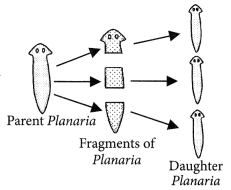
During the process of reproduction, new organism is formed from the complete parent organism. However, during fragmentation, a fragment of original parent body grows into new individual.
Question 43.
On cutting the body of an organism into many pieces, it was observed that many of these pieces developed as new individuals. Name the process and list two organisms in which this process may be observed. Draw a schematic diagram to illustrate the changes that are likely to be observed during the development of new individuals in any one of the organisms named. (Delhi 2014)
Answer:
On cutting the body of an organism into many pieces, each of these pieces develop as new individuals. This process is known as regeneration.
Hydra and Planaria are the organism in which this process may be observed. Poliowing is the diagram showing development of new individuals by regeneration of body parts of a parent Hydra: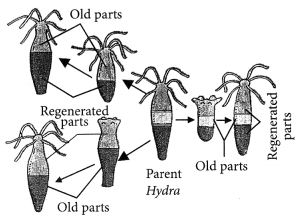
Question 44.
Draw diagrams to explain the regeneration that takes place in each of the body parts of Planaria when its body is cut into three pieces. Name any other organism in which a similar process can be observed. (Delhi 2014)
Answer:
Refer to answer 42.
Hydra is the organism in which regeneration is observed.
Question 45.
List any two modes of asexual reproduction in animals. Under which mode of reproduction is vegetative propagation placed and why? List two advantages of vegetative propagation. (AI 2014)
Answer:
The two modes of asexual reproduction in animals are : (i) fission and (ii) fragmentation. Vegetative propagation is placed under asexual mode of reproduction because in this mode new plants are obtained from the parts of old plants (like stems, roots and leaves), without the help of any reproductive organs. Also refer to answer 38.
Question 46.
What is vegetative propagation? List its two advantages. Select two plants raised by this method from the list given below:
Wheat, Tomato, Rose, Pea, Gram, Corn, Banana (Foreign 2014)
Answer:
Refer to answers 38 and 26.
Question 47.
(a) Name the mode of reproduction of the following organisms and state the important feature of each mode :
(i) Planaria
(ii) Hydra
(iii) Rhizopus
(b) We can develop new plants from the leaves of Bryophyllum. Comment.
(c) List two advantages of vegetative propagation over other modes of reproduction. (2020)
Answer:
(a) (i) Planaria – Regeneration
Regeneration of organism from its cut body parts occurs by the process of growth and development.
Regeneration is an asexual mode of reproduction common in lower plants and animals.
(ii) Hydra – Budding
In budding, a small part of the body of the parent organism grows out as a bud which on detaching forms a new organism.
Budding occurs in yeast, some protozoans and certain lower animals.
(iii) Rhizopus – Spores
Spores are usually produced in sporangia.
Spore formation is a common method of an asexual reproduction in bacteria and most of the fungi.
(b) The leaves of a Bryophyllum have special type of buds in their margins. These buds may get detached from the leaves, fall to ground and then grow to produce new Bryophyllum plants. The buds can also drop to the ground together with the leaf and then grow to produce new plants.
(c) Advantages of vegetative propagation are :
- It is a quick method of propagation.
- The new plants produced by artificial vegetative propagation are exactly like the parent plants.
- Many plants can be grown from one plant by vegetative propagation.
Question 48.
(a) What is fragmentation in organisms? Name a multicellular organism which reproduces by this method.
(b) What is regeneration in organism? Describe regeneration in Planaria with the help of a suitable diagram. (Delhi 2011)
Answer:
(a) Fragmentation is the mode of reproduction in which parent body breaks into two or more fragments and each fragment develops into a new individual. It is a method of reproduction in many filamentous algae, mycelial fungi and thalloid bryophytes, e.g., Spirogyra.
The given figure shows the process of fragmentation in Spirogyra: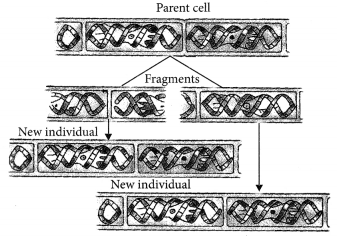
(b) Regeneration may be defined as the ability of an organism to regenerate lost part of the body which have been removed as by injury or autotomy. Many fully differentiated organisms use this ability as a mode of reproduction and give rise to new individual organisms from their body parts. It is common in Hydra, Planaria, etc.
The process of regeneration in Planaria is described in the figure given below: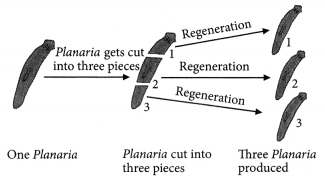
Question 49.
With the help of suitable diagrams, explain the various steps of budding in Hydra. (AI 2011)
Answer:
In multicellular organisms, such as Hydra, a small protuberance arises from one side of the body. The protuberance grows and develops adult like structure. In Hydra, it develops a hypostome and tentacles at its free end. It develops a basal disc at the point of attachment with the parent organism and finally gets detached to lead an independent life. Also refer to answer 21.
Question 50.
What is binary fission in organisms? With the help of suitable diagrams, describe the mode of reproduction in Amoeba. (AI2011)
Answer:
Binary fission is the division of adult parental body into two nearly equal daughter cells. It is the simplest and most common method of asexual reproduction found in protistan protozoans, i.e., Amoeba, Paramecium, etc.
Amoeba reproduces by binary fission by dividing its body into two parts. When the Amoeba cell has reached its maximum size of growth, then first the nucleus of Amoeba lengthens and divides into two parts. After that the cytoplasm of Amoeba divides to form two smaller Amoeba (called daughter amoebae).
Diagrammatic representation of binary fission in Amoeba is as follows :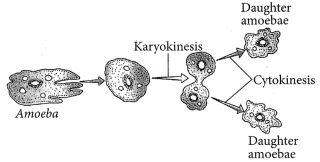
Question 51.
(a) What is spore formation?
(b) Draw a diagram showing spore formation in Rhizopus.
(c) List two advantages for organisms to reproduce themselves through spores. (Foreign 2011)
Answer:
(a) Spore formation is the process of formation of microscopic reproductive structures called spores. These spores when detaches from the parent gives rise to a new individual. Reproduction by the formation of spores is a common method of asexual reproduction in some bacteria and most of the fungi.
(b) Following figure shows the process of spore formation in Rhizopus: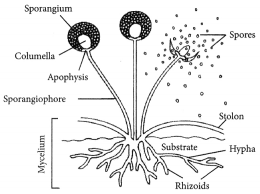
(c) Two advantages to spore producing organism are as follows:
- Spores help organism to survive harsh environmental conditions as spores are covered by thick walls which protect them until they come in contact with moist surface and germinate.
- Spores are generally very small and light. Therefore, it ensures easy dispersal by wind, water and animal.
Question 52.
Fertilisation is the process of
(a) transfer of male gamete to female gamete
(b) fusion of nuclei of male and female gamete
(c) adhesion of male and female reproductive organs
(d) the formation of gametes by a reproductive organ. (2020)
The growing size of the human population is a cause of concern for all people. The rate of birth and death in a’given population will determine its size. Reproduction is the process by which organisms increase their population. The process of sexual maturation for reproduction is gradual and takes place while general body growth is still going on. Some degree of sexual maturation does not necessarily mean that the mind or body is ready for sexual acts or for having and bringing up children. Various contraceptive devices are being used by human beings to control the size of population.
Answer:
(b) fusion of nuclei of male and female gamete
Question 53.
List two common signs of sexual maturation in boys and girls.
Answer:
(a) Two common signs of sexual maturation in boys and girls are :
- Growth of pubic hair and extra hair in the armpits.
- Development of oily skin and pimples.
Question 54.
What is the result of reckless female feticide?
Answer:
Female feticide is reducing the number of girls drastically in our country, which is also declining male-female sex ratio.
Question 55.
Which contraceptive method changes the hormonal balance of the body?
Answer:
Chemical contraceptive method changes the hormonal balance of the body.
Question 56.
Write two factors that determine the size of a population. (2020)
Answer:
The rate of birth and death in a given population will determine the size of a population.
Question 57.
What are all organisms called which bear both the sex organs in the same individual? Give one example of such organism. (AI 2016)
Answer:
Organisms which bear both male and female sex organs in the same individual are called bisexual. For example, Hibiscus.
Question 58.
List two functions of ovary of human female reproductive system. (AI 2016)
Answer:
Two functions of ovary of human female are:
- production of female gametes, i.e., ova
- secretion of female hormones, i.e., estrogen and progesterone.
Question 59.
List two unisexual flowers. (Foreign 2016)
Answer:
Flowers of papaya and cucumber are unisexual.
Question 60.
Why is fertilisation not possible without pollination? (Foreign 2016)
Answer:
The process of pollination (in plants) ensures that male gametes bearing structure called pollen comes in contact with the female reproductive structure of the plant. Once the male and female gametes are in close vicinity, they fuse and fertilisation is accomplished. Hence, fertilisation cannot take place without pollination.
Question 61.
Name the parts of a bisexual flower that are not directly involved in reproduction. (Foreign 2015)
Answer:
Calyx and corolla are parts of a flower that are not directly involved in reproduction.
Question 62.
No two individuals are absolutely alike in a population. Why? (Delhi 2014)
Answer:
No two individuals are absolutely alike in a population because sexual reproduction promotes diversity of characters in the offspring by providing genetic variation.
Question 63.
Identify and write the male reproductive parts from the list of different parts of a flower given below:
Stigma, Sepal, Anther, Petal, Ovule, Filament (Delhi 2013C)
Answer:
The male reproductive parts that are present in a flower frorti given list are:
(i) anther and (ii) filament.
Question 64.
What is the main difference between sperms and eggs of humans? Write the importance of this difference. (AI 2014)
Answer:
The main difference between sperms and eggs of humans is that a sperm has X or Y chromosome whereas egg has X chromosome. This helps in determination of the sex of a person and maintaining the genetic continuity in the organisms.
Question 65.
“The chromosomal number of the sexually producing parents and their offspring is the same”. Justify this statement. (AI 2014)
Answer:
In sexual reproduction, two gametes, male and female, combines together to form a new cell ‘zygote’. The reproductive cells or gametes contain only half the amount of DNA as compared to the non-reproductive cells of an organism. So, when a male gamete combines with a female gamete during sexual reproduction, then the new cell ‘zygote’ will have the normal amount of DNA. For example, the human sperm has 23 chromosomes and the human egg has also 23 chromosomes. So when a sperm and an egg fuse together during fertilisation, then the zygote formed will have 23 + 23 = 46 chromosomes, which is the normal number of chromosomes in humans.
Question 66.
List two preparations shown every month by the uterus in anticipation of pregnancy in humans. (Foreign 2014)
Answer:
The two preparations shown every month by the uterus in anticipation of pregnancy in human are:
(i) the wall of uterus becomes thick to receive the fertilised egg and
(ii) the uterine wall is richly supplied with blood to nourish the growing embryo.
Question 67.
State one genetically different feature between sperms and eggs of humans. What is its consequence? (Delhi 2012)
Answer:
A sperm may have X or Y chromosomes whereas egg have X chromosomes. The consequence of this is that sperm decides the sex of the child because eggs contribute only X chromosome while sperms contribute either X or Y chromosomes to the offspring. Therefore, if a child inherits X chromosome from her father, will be a girl and the one that inherit Y chromosome will be a boy.
Question 68.
State the role of placenta in the development of embryo. (AI 2012)
Answer:
Placenta is a physiological connection between an embryo and uterine wall of the mother through which nutrients and other useful substances enter into fetus from mother’s blood and waste products like urea and carbon dioxide are expelled into mother’s blood from fetus.
Question 69.
List the parts of human male reproductive system which contribute fluid to the semen. State two advantages semen offers to the sperms. (Foreign 2012)
Answer:
The secretion of male accessory reproductive glands, i.e., seminal vesicles, prostate gland and Cowper’s glands contribute fluid to the semen. The two advantages that semen offers to the sperms are:
(i) it provides nutrition to the sperms and
(ii) it also activates the sperms and make their transport easier into the vagina of female during sexual act.
Question 70.
Explain giving one example of each, the unisexual and the bisexual flowers. (Delhi 2011)
Answer:
(i) Unisexual flowers : These flowers contain either stamens (male reproductive part) or carpel (female reproductive part). Example: Papaya, watermelon.
(ii) Bisexual flowers : The flower is said to be bisexual when both male and females parts, i.e., stamens and carpels, are present on the same flower. Example: Hibiscus, mustard.
Question 71.
Describe the role of fallopian tubes in the female reproductive system. (AI2011)
Answer:
Fallopian tubes are a pair of elongated, ciliated, muscular and tubular structures extending from close to ovaries to uterus. It is the site of fertilisation and helps in the conduction of ovum or zygote towards uterus by ciliary action and peristalsis.
Question 72.
Explain the terms:
(i) Implantation of zygote
(ii) Placenta (Foreign 2011)
Answer:
(i) Implantation of zygote refers to the process of attachment of the blastocyst on the inner wall of the uterus, It occurs on 7th day after fertilisation and is controlled by estrogen and progesterone hormones.
(ii) Refer to answer 68.
Question 73.
Define the term pollination. Differentiate between self-pollination and cross-pollination. What is the significance of pollination? (2020)
Answer:
The process of transfer of pollen grains from anther of a flower to the stigma of the same flower or another flower of the same species is known as pollination. The two inodes of pollination are self pollination and cross pollination.
Differences between self pollination and cross pollination are as follows:
| Character | Self pollination | Cross pollination |
| Occurrence | Occurs within a flower or between two flowers of the same plant. | Occurs between two flowers of two different plants of the same species. |
| Agent of pollination | Usually no external agent of pollination is required. | External agents such as wind, water, insects and birds are required. |
| Production of pollen grains | Produced in small numbers, thus no wastage of pollen grains occurs. | Produced in large numbers thus, wastage of pollen grains occurs. |
| Appearance of flowers | Flowers are generally not attractive. | Flowers are attractive with coloured petals. |
| Fragrance and nectar | Commonly flowers do not produce scent or nectar. | Flowers generally produces scent and nectar. |
| Nature of offspring produced | Offspring produced have genetic makeup identical to the parent plant, no variation occurs. | Offspring produced may differ in genetic make-up and variations occur. |
Pollination is important because it brings pollen grains to the female reproductive part (carpel) of the plant that leads to fertilisation.
Question 74.
(a) What provides nutrition to human sperms? State the genetic constitution of a sperm.
(b) Mention the chromosome pair present in a zygote which determines the sex of (i) a female child and (ii) a male child. (2020)
Answer:
(a) The secretions of seminal vesicles and prostate gland provides nutrition to the human sperms and also make their further transport easier. The genetic constitution of a sperm can be 50% have X chromosome and 50% have Y chromosome.
(b) (i) XX – Female child
(ii) XY – Male child
Question 75.
State the basic requirement for sexual reproduction. Write the importance of such reproductions in nature. (Delhi 2017)
Answer:
The basic requirement for sexual reproduction is involvement of both sexes, i.e., male and female, to produce an offspring. It takes place by the combination of gametes which come from two different parents.
The importance of sexual reproduction in nature are :
(i) Fusion of male and female gametes coming from two different and sexually distinct individuals, exhibit diversity of characters in offspring.
(ii) Meiosis during gametogenesis provides opportunities for new combination of genes, which leads to variation required for evolution and plays a prominent role in the origin of new species. Variations lead to the appearance of such characters, which fit to the changing environment, resulting in the survival of the species.
Question 76.
State the changes that take place in the uterus when:
(a) Implantation of embryo has occurred.
(b) Female gamete/egg is not fertilised. (Delhi 2017)
Answer:
(a) Implantation is the close attachment of the blastocyst (young multicellular embryo) to the uterine wall. It is fullowed by a number of developmental changes in the thickened wall of uterus. An intimate connection between the fetal membrane and the uterine wall called placenta is formed. This is a disc which is embedded in the uterine wall. The placenta serves as the nutritive, respiratory and excretory organ of the fetus.
(b) When the female gamete/egg is not fertilised, this lining is not needed any longer. So, the lining slowly breaks and comes out through vagina as blood and mucus. This cycle takes place every month and is known as menstrual cycle.
Question 77.
List any two steps involved in sexual reproduction and write its two advantage. (Delhi 2017)
Answer:
The two main steps involved in sexual reproduction are:
- formation of male and female gametes.
- Fusion of a male gamete with a female gamete to form a new cell called zygote by the process of fertilisation.
The two important advantages of sexual reproduction are:
- It promotes diversity of characters in the offspring through genetic variations.
- It plays an important role in continuous evolution of better organisms that may lead to the origin of new species.
Question 78.
List three techniques that have been developed to prevent pregnancy. Which one of these techniques is not meant for males? How does the use of these techniques have a direct impact on the health and prosperity of a family? (AI 2017)
Answer:
Methods developed to prevent pregnancy are:
- barrier method, i.e., use of condoms, diaphragm, etc.
- chemical method, i.e., use of oral pills or vaginal pills.
- surgical method, i.e., vasectomy and tubectomy. Out of these methods, chemical method is not meant for males.
Use of these techniques help to keep control over number of children in a family, which directly effects prosperity of a family. One of the most common reason for deterioralion of women’s health is frequent conception and child bearing. Controlled childbirth will directly affect women health and this will indirectly affect the prosperity of family and nation.
Question 79.
How do organisms, whether reproduced asexually or sexually maintain a constant chromosome number through several generations? Explain with the help of suitable example. (Delhi 2016)
Answer:
In organisms reproducing asexually, only single parent is involved in reproduction. Therefore, amount of DNA remains same from parent to offspring. For example in Amoeba, whole organism divides into two daughter individuals by binary fission. Therefore, amount of DNA remain constant.
In organisms reproducing sexually, reproduction take place with the help of formation of haploid gametes. Gametes are special type of cells called reproductive cells which contain only half the amount of DNA as compared to the normal body cells of an organism. So, when a male gamete combines with a female gamete during sexual reproduction, then the new cell ‘zygote’ will have the normal amount of DNA. For example, the human sperm has 23 chromosomes and the human egg (or ovum) has also 23 chromosomes. So, when a sperm and an egg fuse together during fertilisation, then the zygote formed will have 23 + 23 = 46 chromosomes, which is the normal number of chromosomes.
Question 80.
Name the parts A, B and C shown in the following diagram and state one function of each. (Delhi 2016)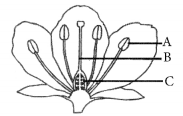
Answer:
In the given figure, part A is anther, part B is style and part C is ovule.
Anther (A) is a part of male reproductive organ of flower called stamen. Large number of pollen grains are formed inside anther. Style (B) and ovule (C) are parts of female reproductive organ of flower called carpel / pistil.
Style is a long conducting tube which gives the passage to pollen tube carrying male gametes so that it reaches ovary which contains one or more ovules. Ovules contain female gamete or egg. On fertilisation ovary converts into fruit and ovules give rise to seeds.
Question 81.
Suggest three contraceptive methods to control the size of human population which is essential for the health and prosperity of a country. State the basic principle involved in each. (Delhi 2016)
Answer:
Three contraceptive methods which can help to control human population are:
(i) Condom : It is a mechanical barrier which does not allow sperms and ovum to meet, hence prevents fertilisation. Condoms are made of thin rubber/latex sheath used to cover the penis in the male and vagina/cervix in female just before coitus (intercourse) so that the ejaculated semen is not released in the female reproductive tract.
(ii) Intrauterine devices (IUDs): These are devices inserted by doctors or expert nurses in the uterus through vagina. These are presently available as non-medicated IUDs, copper releasing IUDs (CuT, etc.) and hormone releasing IUDs. They increase phagocytosis of sperms within uterus and suppress sperm motility and its fertilising capacity. They also make uterus unsuitable for implantation and cervix hostile to sperms.
(iii) Oral pills : These pills contain progesterone alone or a combination of progestogen and estrogen. They inhibit ovulation and make uterus unsuitable for implantation, hence prevent fertilisation.
Question 82.
What are the functions of testes in the human male reproductive system? Why are these located outside the abdominal cavity? Who is responsible for bringing about changes in appearance seen in boys at the time of puberty? (Delhi 2016)
Answer:
Testes, in human males, are the primary reproductive organs. They are the site of sperm formation. The testes also produce male sex hormone testosterone. Testes are located outside the abdominal cavity because sperm formation requires a lower temperature than normal body temperature. The temperature of the testes in the scrotum is about 2-2.5°C lower than normal body temperature. This temperature is ideal for sperm formation and development. Hormone testosterone brings about the development of secondary sexual characters during puberty in boys like growth of facial hair, deepening of voice, growth of scrotum and penis, accumulation of muscle mass, etc., and also regulates formation of sperms.
Question 83.
What is meant by pollination? Name and differentiate between the two modes of pollination in flowering plants. (Delhi 2016)
Answer:
Refer to answer 73.
Question 84.
(a) List two reasons for the appearance of variations among the progeny formed by sexual reproduction.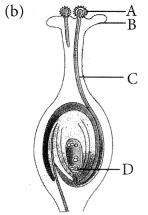
(i) Name the part marked A in the diagram.
(ii) How does A reaches part B?
(iii) State the importance of the part C.
(iv) What happens to the part marked D after fertilisation is over? (AI 2016)
Answer:
(a) Variations arise in sexually reproducing organisms on account of the following:
(i) Genetic variations occur of because DNA copying mechanism is not absolutely accurate.
(ii) Creation of new combinations of genetic variations because variations from two individuals combine during fusion of gametes.
(b) (i) A is pollen grain.
(ii) Part B is stigma. It is the part of pistil (female reproductive organ) that receives pollen grains. Pollen grains reach stigma through various agencies like wind, water, insect, etc.
(iii) Pollen tube (C) carries male gametes to the ovule present in ovary. Male gametes fuse with egg and secondary nucleus to give rise to zygote and endosperm.
(iv) Female gamete (D) fuses with male gamete and converts to embryo after fertilisation.
Question 85.
What is pollination? List its two types and write a distinguishing feature between the two. (Foreign 2016)
Answer:
Refer to answer 73.
Question 86.
What is sexual reproduction? List its four significances. (Foreign 2016)
Answer:
Sexual reproduction is the process of production of offspringby the fusion of male and female gametes. Here, haploid gametes fuse to form diploid zygote which develop into a mature organism.
Significance of sexual reproduction are as follows:
- Sexual reproduction gives rise to genetic variations because of genetic recombination that takes place during fusion of gametes.
- Progenies arising through sexual reproduction sometimes show better combination of traits and get better adapted to their surroundings.
- Genetic recombination, interaction, etc., during sexual reproduction provide vigour and vitality to the offspring.
- Variations in genes play an important role in evolution.
Question 87.
Name the reproductive parts of an angiosperm. Where are these parts located? Explain in brief the structure of its female reproductive parts. (Foreign 2016)
Answer:
The reproductive parts of an angiosperm are stamen (male reproductive part) and carpel/pistil (female reproductive part). These are located in the flowers of an angiospermic plant.
The given diagram shows the structure of female reproductive part of a flower: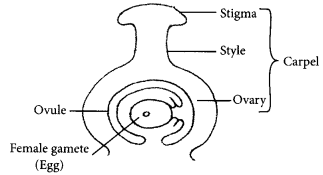
A Carpel is made of three parts: stigma, style and ovary. The top part of carpel is called stigma. Stigma is for receiving the pollen grains during pollination. Stigma is sticky so that pollen can stick to it. The middle part of carpel is called style. Style is a tube which connects stigma to the ovary. The swollen part at the bottom of a carpel is called ovary. The ovary contains ovules. Ovules contain the female gametes or female sex cells (egg) of the plant. There are usually many ovules in the ovary. Each ovule contains only one female gamete of the plant.
Question 88.
(a) Mention the role of the following organs of human male reproductive system.
(i) Testes (ii) Scrotum (iii) Vas deferens
(iv) Prostate gland
(b) What are the two roles of testosterone? (Foreign 2016)
Answer:
(a) (i) Testes : The two testes in male are the sites where male gametes, i.e., sperms are formed. Testes also produce the male sex hormone called testosterone.
(ii) Scrotum : The scrotum is a pouch of skin that lie outside abdominal cavity. The two testes lie in respective scrotal sacs. The scrotum acts as a thermoregulator and provides an optimal temperature for the formation of sperms.
(iii) Vas deferens : This is a straight tube, about 40 cm long, which carries the sperms to the seminal vesicles, where mucus and a watery alkaline fluid containing fructose, mix with the sperms.
(iv) Prostate gland : It is a single large gland that surrounds the urethra and produces a milky, slightly acidic secretion. Secretion of prostate gland nourishes and activates the sperm to swim.
(b) Two roles of testosterone are:
(i) It plays a key role in development of male secondary sex organs such as prostate, etc.
(ii) It promotes the secondary sexual character-istics in males such as increased muscle and bone mass, growth of body hair, etc.
Question 89.
List any four methods of contraception used by humans. How does their use have a direct effect on the health and prosperity of a family? (Delhi 2015, 2014)
Answer:
The four methods of birth control which deliberately prevent fertilisation in humans are:
- Barrier method- These are physical devices to prevent the entry of sperm in the female, e.g., condoms.
- Chemical method – It involves the use of oral pills that check ovulation. These are mainly hormonal preparations and contain estrogen and progesterone.
- Intrauterine contraceptive device-These devices are implemented into uterus, e.g., copper – T, to prevent fertilisation.
- Surgical methods : These methods involves removal of a small jJortion of vas deferens in males or fallopian tube in females to prevent fertilisation. Contraception prevents frequent pregnancies and sexually transmitted diseases thus supports good health and prosperity of a family.
Question 90.
What are sexually transmitted diseases? List two examples each of diseases caused due to
(i) bacterial infection and (ii) viral infection. Which device or devices may be used to prevent the spread of such diseases? (Delhi 2015)
Answer:
The diseases that are spread by sexual contact with an infected person are called sexually transmitted disease (STDs).
(i) Bacterial infection causes gonorrhoea, syphilis.
(ii) Viral infection causes AIDS, genital herpes. STDs can be prevented by using male and female condoms.
Question 91.
List six specific characteristics of sexual reproduction. (AI 2015)
Answer:
Six specific characteristics of sexual reproduction are as follows:
- Two different sexes, i.e., male and female are involved in this process.
- Sexual reproduction involves formation of special sex cells called gametes.
- Fusion of gametes or fertilisation takes place in the body of female (internal fertilisation) or outside (external fertilisation).
- Offspring inherit traits from both parents (heredity) and also show some new traits of their own (variation), hence they are not clones of the parents.
- Variations in sexually reproducing organisms arises on account of crossing over during meiotic division during gamete formation.
- It plays a prominent role in origin of new species as it leads to variations which accumulate over a period of time and get carried to successive generations.
Question 92.
List four points of significance of reproductive health in a society. Name any two areas related to reproductive health which have improved over the past 50 years in our country. (AI 2015)
Answer:
The general awareness regarding reproductive health in a society is significant as :
- Maintenance of personal hygiene among youngsters and proper knowledge of their reproductive parts helps them adjust with the physical changes and cope with emotional disturbances.
- Reproductively healthy society must be free from the curse of child marriage which begets many complications at the level of individual and society both.
- Proper care of expecting mothers, monitoring their health after child birth and care of new born help in building a healthy society.
- Married couples aware of contraceptive methods lead a better married life as they are capable of avoiding unwanted pregnancies and have negligible chances of contracting sexually transmitted diseases.
In past 50 years, various areas related to reproductive health have been launched which have improved the reproductive health of our society in following ways: Two of them are :
(i) reduced mortality rate of mother and infant
(ii) birth control due to easily available contraceptive and reduced STDs cases.
Question 93.
Draw longitudinal section of a bisexual flower and label the following parts on it.
(i) Anther
(ii) Ovary
(iii) Stigma
(iv) Style (Foreign 2015)
Answer:
Longitudinal section of a bisexual flower is as follows: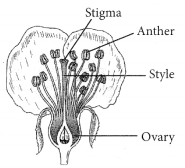
Question 94.
What is placenta? Explain its function in humans. (Foreign 2015, AI 2014)
Answer:
Placenta is an intimate connection between fetus and uterine wall of the mother to exchange the materials. It is a disc shaped structure embedded in the uterine wall. It contains villi on embryo’s side and blood spaces towards mothers side. Blood spaces surround villi.
Placenta performs the following functions:
- All nutritive elements from maternal blood pass into the fetus through it.
- Placental helps in respiration, i.e., supply of oxygen and removal of CO2 from fetus to maternal blood.
- Fetal excretory products diffuse out into maternal blood through placenta and are excreted by mother.
- Placenta also secretes hormone.
Question 95.
Write one main difference between asexual and sexual mode of reproduction. Which species is likely to have comparatively better chances of survival – the one reproducing asexually or the one reproducing sexually? Justify your answer. (Foreign 2015, AI 2014)
Answer:
Difference between asexual and sexual mode of reproduction is as follows :
Asexual reproduction :
Gametes are not formed hence fertilisation does not take place.
Sexual reproduction :
Gametes are always formed and fertilisation takes place to form a zygote.
Species reproducing sexually have a better chance of survival as variation occurs only during the sexual reproduction. Variations are necessary for evolution and to increase chances of survival in changed environmental conditions.
Question 96.
Why is DNA copying an essential part of the process of reproduction? What are the advantages of sexual reproduction over asexual reproduction? (Foreign 2015)
Answer:
DNA copying is an essential part of the process of reproduction as it results in passing of nearly same genetic information from parents to the offsprings. DNA replication also ensures that same number of chromosomes are passed from parents to offspring.
Advantages of sexual reproduction over asexual reproduction is that sexual reproduction provides variations which is a major factor for evolution that helps in survival of species in changing environment.
Question 97.
Draw a diagram of the longitudinal section of a flower exhibiting germination of pollen on stigma and label (i) ovary (ii) male germ cell,
(iii) female germ cell and (iv) ovule on it. (Foreign 2015)
Answer:
The diagram of the longitudinal section of flower is as follows: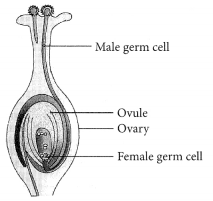
Question 98.
Write names of those parts of a flower which serve the same function as the following do in the animals
(i) testes
(ii) sperm
(iii) ovary
(iv) egg. (Delhi 2014)
Answer:
The parts of a flower which serve the same function as following do in the animals are
(i) testes – anther of stamen
(ii) sperm – pollen
(iii) ovary – ovary of pistil
(iv) egg – female germ cell present in ovule.
Question 99.
List four methods of contraception used by humans.
Justify the following statement.
“The use of contraceptive methods has a direct effect on the health and prosperity of a family.” (AI 2014)
Answer:
Refer to answer 89.
Question 100.
Describe in brief the function of the various parts of the female reproductive part of a bisexual flower. (Foreign 2014)
Answer:
Refer to answer 87.
Question 101.
On the notice board of ultrasound clinics it is generally stated. “Here prenatal sex determination and disclosure of sex (boy or girl before birth) of fetus is not done. It is prohibited and punishable under law.”
(a) List two advantages of imposing ban on prenatal sex determination.
(b) What can students do to educate the society about the following?
(i) The ill-effects of indiscriminate female feticide.
(ii) Adopting small family norms. (Foreign 2014)
Answer:
(a) The two advantages of imposing ban on prenatal sex determination are
(i) check on female feticide
(ii) improving sex ratio in the country.
(b) Students should educate the society as that
(i) female feticide is reducing the number of girls drastically in some societies. For a healthy society, the male-female sex ratio must be maintained at almost the same level. Due to reckless female feticide, the male-female child sex ratio is declining at an alarming rate in some sections of our society.
(ii) Children in a small family can be provided with all the resources from education, good amenities like food, clothing and healthy life style. As the family grows larger, the resources should be shared with increased number of member. Having fewer children also keeps the mother in good health.
Question 102.
Name the two reproductive parts of a bisexual flower which contain the germ cells. State the location and function of its female reproductive part. (Foreign 2014)
Answer:
The two reproductive parts of a bisexual flower which contain the germ cells are carpel (female reproductive part) and stamen (male reproductive part). Carpel is situated in the centre of the flower as a flask-shaped structure. A carpel is made up of three parts-stigma, style and ovary. The distal part of a carpel is called stigma. Stigma is responsible for receiving pollen during pollination. Style is an elongated tubular structure which connects stigma with ovary. The basal swollen part of carpel is ovary. Ovary bears several ovules. After fertilisation ovules form seeds and ovary forms the fruit.
Question 103.
Write two examples each of sexually transmitted diseases causes by (i) virus, (ii) bacteria. Explain how the transmission of such diseases be prevented? (Delhi 2013)
Answer:
The infectious (communicable) diseases, which are spread from an infected person to a healthy person by sexual contact, are called sexually transmitted diseases.
Sexually transmitted diseases caused by virus are : AIDS (Acquired Immunodeficiency Syndrome) and genital warts while caused by bacteria are gonorrhoea and syphilis.
Preventive measures for these diseases are:
- educating people in high risk groups.
- mutually faithful monogamous relationship.
- avoiding prostitution, multipartner sex and homosexuality.
- using condoms, etc.
Question 104.
Explain the meaning of sexually transmitted diseases (STDs). Give two examples of STDs each, caused due to (i) bacterial infection and (ii) viral infection. State in brief how the spread of such diseases may be prevented. (Delhi 2012)
Answer:
Refer to answer 103.
Question 105.
List and explain in brief three methods of contraception. (AI 2012)
Answer:
Refer to answer 81.
Question 106.
What is AIDS? Which microbe is responsible for AIDS infection? State one mode of transmission of this disease. Explain in brief one measure for prevention of AIDS. (Foreign 2012)
Answer:
AIDS (Acquired Immunodeficiency Syndrome), is an infectious viral disease which weakens the immune system of human body and generally leads to death. It is caused by a retrovirus called HIV (Human Immunodeficiency Virus). AIDS can be transmitted by having sexual contact with an infected person.
Use of condoms which are physical barriers can reduce the risk of a sexual exposure to HIV.
Question 107.
(a) List two sexually transmitted diseases in each of the following cases:
(i) Bacterial infections
(ii) Viral infections
(b) How may the spread of such diseases be prevented? . (Delhi 2011)
Answer:
Refer to answer 103.
Question 108.
What does HIV stands for? Is AIDS an infectious disease? List any four modes of spreading AIDS. (AI 2011)
Answer:
HIV stands for Human Immunodeficiency Virus. Yes, AIDS is an infectious disease. It is transmitted sexually or through exposure to contaminated blood.
Four modes of spreading AIDS are :
- unprotected sex with an infected partner
- use of contaminated needle and syringes
- use of contaminated razors for shaving
- transfusion of infected blood or blood products.
Question 109.
Expand AIDS. List any four methods of prevention (control) of AIDS. (Foreign 2011)
Answer:
AIDS is expanded as Acquired Immuno-deficiency Syndrome.
Four methods of prevention or control of AIDS are :
- use of sterilised needles and syringes for injecting drugs or vaccine
- to avoid sex with multiple partners
- use of condoms during intercourse
- avoid use of contaminated razor in barber shop.
Question 110.
(a) List three different categories of contraceptive methods.
(b) Why has Government of India prohibited prenatal sex determination by law? State its benefits in the long run.
(c) Unsafe sexual act can lead to various infections. Name two bacterial and two viral infections caused due to unsafe sex. (2020)
Answer:
(a) Three different categories of contraceptive methods are :
(i) Barrier methods, i.e., use of condoms, etc.
(ii) Chemical methods, i.e., use of oral pills or vaginal pills.
(iii) Surgical methods, i.e., vasectomy and tubectomy.
(b) Prenatal sex determination was banned in India in 1994. This was done to prevent sex selective abortion. It is being used to kill the normal female fetus. This killing of the unborn girl child is called female feticide which is reducing the number of girls drastically in some societies of our country. Due to reckless female feticide, male-female sex ratio is declining at an alarming rate. Its benefit in the long run is that the female-male ratio could be maintained for a healthy society.
(c) Bacterial diseases due to unsafe sex are gonorrhoea, syphilis.
Viral diseases due to unsafe sex are AIDS, genital herpes.
Question 111.
(a) In the female reproductive system of human beings, state the functions of:
(i) Ovary
(ii) Oviduct.
(b) Mention the changes which the uterus undergoes, when
(i) it has to receive a zygote.
(ii) no fertilisation takes place.
(c) State the functions of placenta. (2020)
Answer:
(a) (i) Tire ovaries in female are primary sex organs (or female gonads) which perform the dual function – production of female gametes (eggs or ova) and secretion of female sex hormones (estrogen and progesterone).
(ii) Oviducts or fallopian tube are paired tubes originating near to the ovaries of their respective sides and extend upto uterus. The terminal part of fallopian tube is funnel-shaped with finger-like projections called fimbriae lying near ovary. Fimbriae pick up the ovum released from ovary and push it into fallopian tube. Fertilisation also takes place in the oviduct.
(b) (i) As the ovary releases one egg every month, the uterus also prepares itself, every month to receive fertilised egg by making its lining thick and spongy to nourish the zygote if fertilisation takes place.
(ii) When the female gamete/egg is not fertilised, this lining is not needed any longer. So, the lining slowly breaks and comes out through vagina as blood and mucus through menstrual cycle that takes place every month.
(c) Placenta performs the following functions :
- All nutritive elements from maternal blood pass into the fetus through it.
- Placenta helps in respiration i.e., supply of oxygen and removal of CO2 from fetus to maternal blood.
- Fetal excretory products diffuse out into maternal blood through placenta and are excreted by mother.
- Placenta also secretes hormone.
Question 112.
(a) Draw a diagram showing germination of pollen on stigma of a flower and mark on it the following organs/parts:
(i) Pollen grain
(ii) Pollen tube
(iii) Stigma
(iv) Female germ cell
(b) State the significance of pollen tube.
(c) Name the parts of flower that develop after fertilisation into:
(i) Seed
(ii) Fruit. (2020)
Answer:
(a) Diagram showing germination of pollen on stigma of a flower is: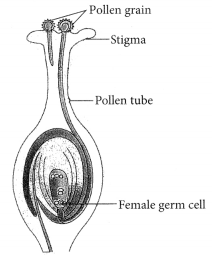
(b) The pollen tube acts as a conduit to transport the male gamete cells from the pollen grain at stigma to the ovules at the base of the carpel for the process of fertilisation.
(c) After fertilisation,
(i) ovule develops into seed and
(ii) ovary develops into fruit.
Question 113.
Draw a neat diagram showing fertilisation in a flower and label (a) pollen tube (b) Male germ cell and (c) Female germ cell on it. Explain the process of fertilisation in a flower. What happens to the (i) ovary and (ii) ovule after fertilisation? (2020)
Answer:
Diagram showing fertilisation in a flower: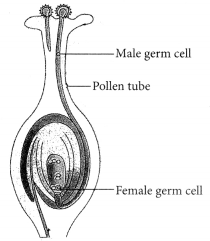
Fertilisation, in plants, occurs when the male gamete present in pollen grain fuses with the female gamete (or egg) present in ovule. When a pollen grain falls on the stigma of the carpel, it bursts open and grows a pollen tube downwards through the style towards the female gamete in the ovary. Male gametes move down the pollen tube. The pollen tube enters the ovule in the ovary. The tip of pollen tube bursts and male gametes comes out of pollen tube. In ovary, the male gamete of pollen combines with the female gamete or egg present in ovule to form a fertilised egg.
After fertilisation,
(i) ovule develops into seed
(ii) ovary develops into fruit.
Question 114.
(a) What is puberty?
(b) Describe in brief the functions of the following parts in the human male reproductive system.
(i) Testes
(ii) Seminal vesicle
(iii) Vas deferens
(iv) Urethra
(c) Why are testes located outside the abdominal cavity?
(d) State how sperms move towards the female germ cell. (2020)
Answer:
(a) The age at which the sex hormones begin to be produced and the boy and girl becomes sexually mature, i.e., able to reproduce is called puberty.
(b) (i) Testes : The two testes in male are the sites where male gametes, i.e., sperms are formed. Testes also produce the male sex hormone called testosterone.
(ii) Seminal vesicles are one pair of sac-like structures near the base of bladder. Seminal fluid is a watery alkaline fluid that contains nutrients (fructose) which serve as a source of energy for the sperm. Each seminal vesicle releases its contents into the ejaculatory duct during ejaculation.
(iii) Vas deferens : This is a straight tube, about 40 cm long, which carries the sperms to the seminal vesicles, where mucus and a watery alkaline fluid containing fructose, mix with the sperms.
(iv) Urethra : It is a long tube that arises from urinary bladder. Urethra carries urine from the bladder as well as sperms from the vas deferens, through the penis.
(c) Testes are located outside the abdominal cavity because sperm formation requires a lower temperature than normal body temperature. The temperature of the testes in the scrotum is about 2-2.5°C lower than normal body temperature. This temperature is ideal for sperm formation and development.
(d) The sperms present in the testes of man are introduced into the vagina of the woman through penis during copulation. Millions of sperms are released into the vagina at one time. The sperms are highly active and mobile. They travel from here upward through the uterus at the top of fallopian tube within five minutes.
Question 115.
Based on the given diagram answer the questions given below: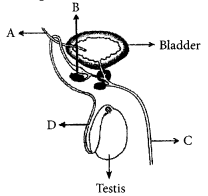
(a) Label the parts A, B, C and D.
(b) Name the hormone secreted by testis and mention its role.
(c) State the functions of B and C in the process of reproduction. (2020)
Answer:
(a) A – Ureter
B – Seminal vesicle
C – Urethra
D – Vas deferens
(b) Testes produce male sex hormone testo-sterone. Hormone Testosterone brings about the development of secondary sexual characters during puberty in boys like growth of facial hair, deepening of voice, build up of muscle mass and also regulates formation of sperms.
(c) Seminal vesicles (B) release its contents into the ejaculatory duct during ejaculation. Urethra (C) carries sperms from the vas deferens through the penis.
Question 116.
(a) List two reasons of using contraceptive methods by married couples.
(b) Write in proper sequence the processes going on in the different organs of the reproductive system of a human female starting from the time of egg production to childbirth. (2020)
Answer:
(a) Two reasons of using contraceptive methods by married couples are :
(i) They prevent frequent or unwanted pregnancies.
(ii) They prevent the transfer of sexually transmitted diseases (STDs).
(b) The female germ cells or eggs are made in ovaries. They are also responsible for the production of some hormones. When a girl is born, the ovaries already contain thousands of immature eggs on reaching puberty.
Some of these start maturing, one egg is produced every month by one of the ovaries. The egg is carried from the ovary to the womb through a thin oviduct or fallopian tube. The oviducts unite into an elastic bag-like structure known as uterus. The uterus opens into the vagina through the cervix. The sperms enter through vagina passage during sexual intercourse. They travel upwards and reach the oviduct where they may meet the egg. The fertilised egg, the zygote gets implanted in the lining of uterus and starts dividing. The mothers body is designed to undertake the development of the child. So, the uterus prepares itself every month to receive and nurture the growing embryo. The lining thickens and is richly supplied with blood to nourish the growing embryo.
After implantation, a disc-like special tissue develops between the uterus wall (called uterine wall) and the embryo (or fetus), which is called placenta. The fetus is connected to placenta in mothers body through umbilical cord. It is through the placenta that all the requirements of the developing fetus like nutrition, respiration and excretion, etc., are met from the mothers body. The development of the child inside the mothers body takes approximately nine months. The child is born as a result of rhythmic contractions of the muscles in the uterus.
Question 117.
(a) Identify the modes of asexual reproduction in each of the following organisms:
(i) Hydra
(ii) Planaria
(iii) Amoeba
(iv) Spirogyra
(v) Rhizopus
(b) List three advantages of vegetative propagation.
(c) Why cannot fertilisation take place in flowers if pollination does not occur? (2020)
Answer:
(a) (i) Hydra – Budding
(ii) Planaria – Regeneration
(iii) Amoeba – Fission
(iv) Spirogyra – Fragmentation
(v) Rhizopus – Spores
(b) Refer to answer 47(c).
(c) Pollination brings male gametes in close proximity to the female reproductive part of flower. In the absence of pollination, there will be no male gametes available for fertilisation with female gametes.
Question 118.
Define pollination. Explain the different types of pollination. List two agents of pollination. How does suitable pollination lead to fertilisation? (Delhi 2019)
Answer:
The process of transfer of pollen grains from anther of a flower to the stigma of the same flower or another flower of the same species is known as pollination. Pollination may be of two major types- (i) self pollination and (ii) cross pollination.
(i) Self pollination is the transfer of pollen grains from the anther to the stigma of the same flower, or to the stigma of another flower of the same plant. This pollination generally takes place in bisexual flowers because they have both male and female gametes in them.
(ii) Cross pollination is the transfer of pollen grains from the anther of a flower of one plant to the stigma of a flower of another plant of the same species. This occurs in unisexual as well as bisexual flowers.
Two agents of pollination are wind and water.
Pollination results in the deposition of related pollen grains over the receptive stigma of the carpel. Pollen grains after landing on stigma, absorb water, swell and then germinate to produce pollen tubes. Many pollen tubes grow into the stigma, but only one passes through the style and then moves towards the ovary. Two non-motile male gametes are formed inside the tube during its growth through the style. After reaching the ovary, pollen tube enters the ovule through the micropyle. The tip of the tube finally pierces the micropylar end of the embryo sac. After penetration, the tip of pollen tube ruptures releasing two male gametes into the embryo sac. The mature embryo sac consists of an egg apparatus (one haploid egg and two synergids), two polar nuclei and three antipodal cells. During the act of fertilisation, one male gamete fuses with the egg to form the diploid zygote.
Question 119.
(a) Identify the given diagram. Name the parts 1 to 5.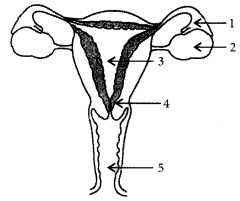
(b) What is contraception? List three advantages of adopting contraceptive measures. (Delhi 2019)
Answer:
(a) The given diagram is the sectional view of human female reproductive system.
The labelled parts are:
1. Funnel of fallopian tube or oviduct
2. Ovary
3. Uterus or womb
4. Cervix
5. Vagina
(b) Contraception is the avoidance of pregnancy. There are several methods of contraception such as:
- Barrier methods (condoms, diaphragm, etc.)
- Chemical methods (spermicide creams and jellies)
- Intrauterine Contraceptive Devices (IUCDs) (Lippes loop, CuT, etc.)
- Natural methods (rhythm method, coitus interruptus)
Surgical methods (vasectomy, tubectomy) Three advantages of adopting contraceptive methods are:
- They prevent frequent or unwanted pregnancies.
- They prevent the transfer of sexually transmitted diseases (STDs).
- They help to regulate the population growth.
Question 120.
(a) Distinguish between cross-pollination and self-pollination. Mention the site and product of fertilisation in a flower.
(b) Draw labelled diagram of a pistil showing the following parts:
Stigma, Style, Ovary, Female germ cell (AI 2019)
Answer:
(a) Refer to answer 73.
Fertilisation takes place in the ovary of a female flower. Inside the ovary, the ovule is fertilised by pollen. After the process of fertilisation, the ovary in the flower thickens and enlarges to form the fruit, whereas the ovule becomes the seed containing the embryo.
(b) The labelled diagram of a pistil is as follows :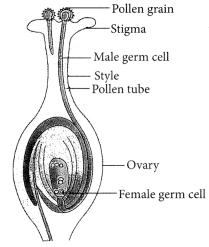
Question 121.
(a) Draw a diagram of human female reproductive system and label the parts:
(i) which produce an egg
(ii) where fertilisation takes place
(b) List two bacterial diseases which are transmitted sexually.
(c) What are contraceptive devices? Give two reasons for adopting contraceptive devices in humans. (AI 2019)
Answer:
(a) The sectional view of human female reproductive system is as follows: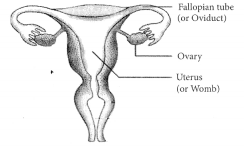
(i) Ovary is the part where eggs develop.
(ii) Fallopian tube is the part where fertilisation takes place.
(b) Gonorrhoea and syphilis are two bacterial diseases which are transmitted sexually by bacterium Neisseria gonorrhoeae and Treponema pallidum respectively.
(c) Contraceptive devices are those devices which are used to prevent pregnancy. It includes diaphragm, condom and intrauterine devices. Contraceptive methods are adopted:
(i) to avoid unwanted birth.
(ii) to keep the population of a country under control.
Question 122.
(a) Write the function of following parts in human female reproductive system:
(i) Ovary (ii) Oviduct (iii) Uterus.
(b) Describe in brief the structure and function of placenta. (2018)
Answer:
(a) Function of human female reproductive part are as follows :
(i) Ovary: The ovaries are primary sex organs (or female gonads), which perform the dual function :
Production of female gametes (eggs or ova)
Secretion of female sex hormones (estrogen and progesterone).
(ii) Oviduct (Fallopian tube): It is a site where egg and sperms meet and fertilisation takes place.
It also conducts the ovum or zygote towards uterus by ciliary action and peristalsis.
(iii) Uterus : It is the seat of implantation, placentation and foetal development. It’s muscular wall helps in expelling of baby during childbirth.
(b) Placenta is an intimate mechanical and physiological connection between fetus and uterine wall of the mother. It is a disc shaped structure embedded in the uterine wall. It contains chorion having villi on the embryo’s side and blood spaces towards mother’s side. Blood spaces surround the villi. Placenta is connected to the fetus by umbilical cord.
Placenta performs the following functions :
- All nutritive elements from maternal blood passes into the fetus through it.
- Placenta helps in respiration, i.e., supply of O2 to the fetus and removal of CO2 from fetus to maternal blood.
- Fetal excretory products diffuse out into maternal blood through placenta and are excreted by mother.
- Placenta also secretes hormones.
- Placenta acts as a barrier between mother and fetus blood and only allows necessary materials to pass through it.
Question 123.
(a) Name the organ that produces sperms as well as secretes a hormone in human males. Name the hormone it secretes and write its functions.
(b) Name the part of the human female reproductive system where fertilisation occurs.
(c) Explain how the developing embryo gets nourishment inside the mother’s body. (Delhi 2017)
Answer:
(a) Refer to answers 88 (a)(i) and (b).
(b) In human female the fertilisation occurs in the oviducts or Fallopian tube.
(c) The developing embryo gets nourishment from the mother’s blood with the help of a special tissue called placenta. This is a disc like structure embedded in uterine wall. It contains villi that provides a large surface area to pass glucose and oxygen from mother to embryo. Placenta links the embryo to the mother through umbilical cord.
Question 124.
(a) Write the functions of each of the following parts in a human female reproductive system.
(i) Ovary
(ii) Uterus
(iii) Fallopian tube
(b) Write the structure and functions of placenta in a human female. (AI 2017)
Answer:
(a) (i) Refer to answer 11 l(a)(i).
(ii) Uterus is a single, pear-shaped, highly muscular, hollow structure present in the pelvic cavity, lying between urinary bladder and rectum. If fertilisation takes place, the embryo gets implanted to the wall of uterus and grows there until birth. Development of fetus occurs inside uterus, hence it is also called womb.
(iii) Refer to answer 111 (a)(ii).
(b) Refer to answer 122(b).
Question 125.
(a) Write the functions of the following parts in human female reproductive system :
(i) Ovary
(ii) Oviduct
(iii) Uterus
(b) Describe the structure and function of placenta. (Delhi 2016)
Answer:
(a) Refer to answers 111(a)(i), (ii) and 124(a)(ii). (b) Refer to answer 122(b).
Question 126.
What is placenta? Describe its structure. State its functions in case of a pregnant human female. (AI 2016)
Answer:
Refer to answer 122(b).
Question 127.
(a) State in brief the functions of the following organs in the human female reproductive system.
Ovary, Fallopian tube, Uterus
(b) What is menstruation? Why does it occur? (Foreign 2016)
Answer:
(a) Refer to answers 111(a)(i), (ii) and 124(a) (ii).
(b) Menstruation is the cyclic discharge of blood along with endometrial lining of the uterus and unfertilised egg in women. It last for 3-5 days. After the release of egg in the females, the uterine lining becomes thickened for the implantation of fertilised egg or zygote. In the absence of fertilisation, the egg along with endometrial lining is expelled out of the body in the form of menstruation.
Question 128.
Write the functions of the following in human female reproductive system.
Ovary, oviduct, uterus
How does the embryo get nourishment inside the mothers body? Explain in brief. (Delhi 2015)
Answer:
Refer to answers 111(a) (i), (ii), 124(a)(ii) and 123 (c).
Question 129.
(a) Name the human male reproductive organ that produce sperms and also secretes a hormone. Write the functions of the secreted hormone.
(b) Name the parts of the human female reproductive system where, (i) fertilisation takes place (ii) implantation of the fertilised egg occurs.
Explain how the embryo gets nourishment inside the mother’s body. (AI 2015)
Answer:
(a) Refer to answers 88(a)(i) and (b).
(b) Refer to answers 122(a) and 123(c).
Question 130.
(a) Identify A, B, C and D in the given diagram and write their names.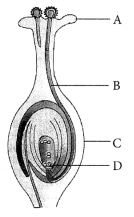
(b) What is pollination? Explain its significance.
(c) Explain the process of fertilisation in flowers. Name the parts of the flower that develop after fertilisation into
(i) seed
(ii) fruit. (Foreign 2015)
Answer:
(a) In the given diagram A is stigma, B is pollen tube, C is ovary and D is female germ cell.
(b) The process of transfer of pollen grains from the anther of a flower to the stigma of the same flower or another flower is known as pollination. Pollination is important because it brings pollen grains to the female reproductive part (carpel) of the plant that leads to fertilisation.
(c) Fertilisation, in plants, occurs when the male gamete present in pollen grain fuses with the female gamete (or egg) present in ovule. When a pollen grain falls on the stigma of the carpel, it bursts open and grows a pollen tube downwards through the style towards the female gamete in the ovary.
Male gametes move down the pollen tube. The pollen tube enters the ovule in the ovary. The tip of pollen tube bursts and male gametes comes out of pollen tube. In ovary, the male gamete of pollen combines with the female gamete or egg present in ovule to form a fertilised egg.
After fertilisation,
(i) ovule develops into seed
(ii) ovary develops into fruit.
Question 131.
(a) Give one example each of unisexual and bisexual flower.
(b) Mention the changes a flower undergoes after fertilisation.
(c) How does the amount of DNA remain constant though each new generation is a combination of DNA copies of two individuals. (Delhi 2014)
Answer:
(a) Unisexual flowers bear organs of only one sex, i.e., either stamen or pistil, e.g., papaya. Bisexual flowers contain both stamen and pistil, e.g., Hibiscus.
(b) After fertilisation, the fertilised egg (or zygote) divides several times to form an embryo within the ovule. The ovule develops a tough coat around it and is gradually converted into a seed. The ovary of flower develops and becomes a fruit (with seeds inside it). The other parts of flower like sepals, petals, stamens, stigma and style dry up and fall off. Only the ovary is left behind. So, at the place on plant vyhere we had a flower originally, we now have a fruit (which is the ovary of the flower containing seeds). A fruit protects the seeds.
(c) The amount of DNA remain constant in each new generation because of formation of haploid gametes. Gametes are special type of cells called reproductive cells which contain only half the amount of DNA as compared to the normal body cells of an organism. So, when a male gamete combines with a female gamete during sexual reproduction, then the new cell ‘zygote’ will have the normal amount of DNA. For example, the human sperm has 23 chromosomes and the human egg (or ovum) has also 23 chromosomes. So, when a sperm and an egg fuse together during fertilisation, then the zygote formed will have 23 + 23 = 46 chromosomes, which is the normal number of chromosomes.
Question 132.
(a) Write the name of the human male reproductive organ that produces sperms and secretes a hormone. Name the hormone secreted and state its function.
(b) Write the site of fertilisation and the part where the zygote gets implanted in the human female.
(c) State, in brief, how an embryo gets its nourishment inside the mothers body. (Delhi 2014)
Answer:
(a) Refer to answers 88 (a)(i) and (b).
(b) Refer to answer 122 (a) (ii), (iii).
(c) Refer to answer 123 (c).
Question 133.
(a) Name the respective part of human female reproductive system :
(i) that produces egg
(ii) where fusion of egg and sperm takes place, and
(iii) where zygote gets implanted.
(b) Describe in brief what happens to the zygote after it gets implanted. (Delhi 2014)
Answer:
(a) Refer to answer 122 (a).
(b) After implantation of zygote or embryo in the thick lining of the uterus, a disc-like special tissue develops between the uterus wall and the embryo, which is called as placenta. Placenta meets all the requirements for developing the fetus like nutrition, respiration, excretion, etc. When fetus (embryo) develops completely, the rhythmic contraction of uterus muscles gradually pushes the baby out of the mother s baby through vagina a baby is born.
Question 134.
(a) Draw a sectional view of human female reproductive system and label that part where
(i) eggs develop
(ii) fertilisation take place
(iii) fertilised egg gets implanted
(b) Describe, in brief, the changes that uterus undergoes
(i) to receive the zygote
(ii) if zygote is not formed. (AI 2014)
Answer:
(a) The sectional view of human female reproductive system is as follows: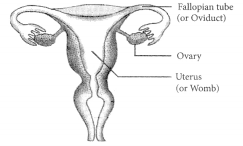
(i) Ovary is the part where eggs develop.
(ii) Fallopian tube is the part where fertilisation takes place.
(iii) Uterus is the part where fertilised egg gets implanted.
(b) (i) When the ovum (or egg) is fertilised in the oviduct, then a zygote is formed. The uterus prepares itself every month to receive a zygote. The inner lining of uterus becomes thick and spongy with lot of blood capillaries in it. This would be required for nourishment and further development of embryo.
(ii) If a sperm is not available at the time of ovulation, then fertilisation of ovum does not take place. Since the ovum (or egg) is not fertilised, so the thick and soft uterus lining having lot of blood capillaries in it is not required. The unfertilised ovum dies within a day and the uterus lining also breaks down. The breakdown and removal of the inner, thick and soft lining of the uterus alongwith its blood vessels in the form of vaginal bleeding is called menstrual flow or menstruation.
Question 135.
(a) Name the parts labelled as A, B, C and D in the diagram given below: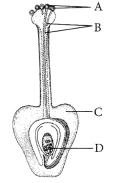
(b) What is pollination? State its significance.
(c) How does fertilisation occur in flowers? Name the parts of the flower that develop into (i) seed, and (ii) fruit after fertilisation. (AI 2014)
Answer:
(a) A represents pollen grains, B represents pollen tubes, C represents ovary and D represents female germ cell.
(b) Refer to answer 130(b).
(c) Refer to answer 130 (c).
Question 136.
List in tabular form the two differences between asexual and sexual mode of reproduction. Name and explain with the help of labelled diagram the process by which Hydra reproduces asexually. (Foreign 2014, Delhi 2013C)
Answer:
Differences between asexual and sexual forms of reproduction are follows :
| Characters | Asexual reproduction | Sexual reproduction |
| (i) Number of parents | The process involves only one cell or one parent, so is called uniparental reproduction. | This process involves two cells or gametes belonging to different parents, so is generally biparental. |
| (ii) Reproductive unit | The whole body of the parent acts as reproductive unit or it can be in a single cell or a bud. | The reproductive unit is gamete, which is unicellular and haploid. |
| (iii) Nature of offspring | The offsprings are genetically similar to parents. | The offsprings differ from parents. |
Hydra is simple multicellular animal. It reproduces asexually by the process of budding. In Hydra first a small outgrowth called ‘bud’ is formed on the side of its body by the repeated mitotic divisions of its cells. This bud then grows gradually to form a small Hydra by developing a mouth. Finally, the tiny new Hydra detaches itself from the body of parent and lives as a separate organism. In this way, the parent Hydra produce a new Hydra. The following figure shows Hydra reproducing by the method of budding.
Question 137.
(a) Name the human male reproductive organ that produces sperms and also secretes hormones. Write the functions of the hormone secreted.
(b) Name the parts of the human female reproductive system where (i) fertilisation and (ii) implantation occur respectively. Explain how the embryo gets nutrition inside the mother’s body. (Foreign 2014)
Answer:
(a) Refer to answers 88 (a) (i) and (b).
(b) Refer to answers 122 (a) and 123 (c).
Question 138.
(a) List three distinguishing features between sexual and asexual types of reproduction.
(b) Explain why variations are observed in the offsprings of sexually reproducing organisms? (Delhi 2013)
Answer:
(a) Refer to answer 136.
(b) Sexual reproduction involves fusion of male and female gametes coming from male and female parents. Variations occur due to (i) fusion of gametes which come from two different and sexually distinct individuals and (ii) meiosis which occurs during gametogenesis and create a new combination of genes. It plays a prominent role in the origin of new species and leads to variations required for evolution. Therefore, offsprings of sexually reproducing organisms show variation.
Question 139.
(a) Identify A, B and C in the given diagram , and write their functions.
(b) Mention the role of gamete and zygote in sexually reproducing organisms. (Delhi 2013)
Answer:
(a) A represents stigma. It receives the pollen grains from the anther of stamen. Stigma is sticky so that pollen can stick to it so that fertilisation can occur. B represents pollen tube. Pollen tube acts as a conduit to transport the male gamete cells from the pollen grain at stigma to the ovules at the base of the carpel for the process of fertilisation. C represent female germ cell. Female germ cell fertilise with male germ cells to forms zygote which develops into an embryo within the ovule. Ovule converts into a seed that gives rise a new individual.
(b) Role of Gamete : Gametes are the reproductive cells involved in sexual reproduction having half of the chromosome. Gametes carry variations generated during its formation (meiosis). A male gamete and a female gamete fuses to form zygote.
Role of Zygote : The fusion of male gamete with female gamete forms a zygote during sexual reproduction. Zygote has normal number of chromosomes and new combinations of variation that express in new generation. The zygote undergoes repeated mitotic divisions to form the embryo which has the potential to form a complete individual.
Question 140.
(a) Give an example of a bisexual flower.
(b) Draw a longitudinal section of a pistil showing the germination of pollen grains. Label the following parts:
(i) Stigma
(ii) Male germ cell
(iii) Female germ cell
(iv) Ovary
(v) Style
(vi) Pollen tube
(c) Mention the site and the product of fertilisation in a flower. (Delhi 2013 C)
Answer:
(a) Hibiscus is an example of a bisexual flower.
(b) Refer to answer 120 (b).
(c) Refer to answer 130 (c).
Question 141.
Define the terms pollination and fertilisation.
Draw a diagram of a pistil showing pollen tube growth into the ovule and label the following: pollen grain, male gamete, female gamete, ovary. (Delhi 2012)
Answer:
The process of transfer of pollen grains from the anther of a flower to the stigma of the same flower or another flower is known as pollination. Fertilisation is the fusion of male gamete with the female gamete (or egg).
Refer to answer 120(b) for figure.
Question 142.
Describe in brief the role of (i) testes (ii)
seminal vesicle, (iii) vas deferens, (iv) ureter and (v) ‘prostate gland in human male reproductive system. (Delhi 2012)
Answer:
(i) Refer to answer 88 (a) (i).
(ii) Seminal vesicles are one pair of sac like structures near the base of bladder. Seminal fluid is a watery alkaline fluid that contains nutrients (fructose) which serve as a source of energy for the sperm. Each seminal vesicle releases its contents into the ejaculatory duct during ejaculation.
(iii) Refer to answer 88(a) (iii).
(iv) Ureter : From hilum of each kidney emerges out a slender, whitish tube called ureter. Ureter of each kidney leaves from the renal pelvis. Each ureter is about 30 cm long, 3 – 4 mm in diameter and opens into urinary bladder by slit-like aperture. The ureters carry urine from kidneys to urinary bladder.
(v) Refer to answer 88(a) (iv).
Question 143.
Distinguish between unisexual and bisexual flowers giving one example of each. Draw a diagram showing process of germination of pollen grains on stigma and label the following parts :
(i) Female germ cell
(ii) Male germ cell
(iii) Ovary (AI 2012)
Answer:
The flowers which contain only one sex organ, either stamens or carpels are called unisexual flowers. E.g., flowers of papaya and watermelon whereas the flowers which contain both the sex organs, stamens as well as carpel, are called bisexual flowers, e.g., flowers of Hibiscus and mustard.
Refer to answer 120(b) for figure.
Question 144.
Draw a diagram of human female reproductive system and label the part
(i) that produces eggs
(ii) where fusion of egg and sperm takes place
(iii) where zygote is implanted.
What happens to human egg when it is not fertilised? (AI 2012)
Answer:
Refer to answer 134 (a) and b (ii).
Question 145.
(a) Explain with the help of a diagram how pollen after landing on the stigma of a flower helps male germ cell to reach the female germ cell. Label the following : ovary, female germ cell, male germ cell and pollen grain.
(b) State the meaning of pollination and mention a distinguishing feature between self-pollination and cross-pollination.
(Foreign 2012)
Answer:
(a) After landing of stigma, the pollen grain does not pass down the stigma. Only its pollen tube does so. The pollen tube eats its way through the solid part of the stigma and style by secreting pectinases and hydrolytic enzymes. It travels intercellularly and chemotropically along the concentration gradient of calcium – boron – inositol sugar complex.
The contents of the pollen grains shift into pollen tube with the tube or vegetative nucleus moving to its tip followed by the two gametes. Further growth of the pollen tube occurs only towards its tip.
In this way, pollen tube helps the male germ cell to reach the female germ cell.
Refer to answer 120 (b) for figure.
(b) Refer to answer 73.
Question 146.
State in brief the changes that take place in a fertilised egg(zygote) till birth of the child in the human female reproductive system. What happens to the egg when it is not fertilised? (Foreign 2012)
Answer:
When the ovum (or egg) is fertilised in the oviduct, then a zygote is formed. The zygote divides rapidly by mitosis as it moves down slowly in the oviduct and forms a ball of cells. This hollow ball of cells, called an embryo sinks into the soft and thick lining of the uterus and gets embedded in it. The embedding of embryo in the thick lining of the uterus is called implantation.
After implantation, a disc-like special tissue develops between the uterus wall (called uterine wall) and the embryo (or fetus), which is called placenta. The fetus is connected to placenta in mothers body through umbilical cord. It is through the placenta that all the requirements of the developing fetus like nutrition, respiration and excretion, etc., are met from the mothers body.
The time period from the fertilisation upto the birth of the baby is called gestation. The average gestation period in humans (or the average during of human pregnancy) is about nine months. During the gestation period, the fetus grows to become a baby. Birth begins when the strong muscles in the walls of the uterus start to contract rhythmically. The rhythmic contraction of uterus muscles gradually pushes the baby out of the mother’s body through vagina and a baby is born. If, a sperm is not available at the time of ovulation, then fertilisation of ovum (or egg) does not take place. Since the ovum (or egg) is not fertilised, so the thick and soft uterus lining having lot of blood capillaries in it is not required. The unfertilised ovum dies within a day and the uterus lining also breaks down. The breakdown and removal of the inner, thick and soft lining of the uterus alongwith its blood vessels is called menstrual flow or menstruation.
Question 147.
(a) Draw a diagram of the longitudinal section of a flower and label on it sepal, petal, ovary and stigma.
(b) Write the names of male and female reproductive parts of a flower. (Delhi 2011)
Answer:
(a) The longitudinal section of a flower is as follows :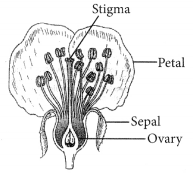
(b) Refer to answer 87.
Question 148.
(a) Draw a diagram illustrating fertilisation in a flowering plant and label on it: male germ cell, ovary, female germ cell and pollen grain.
(b) Distinguish between self pollination and cross pollination. (Foreign 2011)
Answer:
(a) Refer to answer 120 (b). (b) Refer to answer 73.
CBSE Class 10 Science Notes Chapter 8 How do Organisms Reproduce
Asexual Reproduction
- It involves only one parent.
- There is no formation and fusion of gametes.
- The young ones formed are almost identical to each other as well as to the parent cell.
- Asexual reproduction generally occurs during favourable environmental conditions and when there is an abundance of food.
- It is a faster method of reproduction.
Types of Asexual Reproduction is Unicellular Organism
(i) Binary Fission: Seen in bacteria, protozoa like Amoeba, Paramecium. (In these first pseudopodia withdrawn (karyokinesis) the nucleus of the parent cell divides and then the cytoplasm divides (cytokinesis) resulting in the formation of two daughter cells). It occurs during highly favourable conditions. The cell division can occur in any plane as in case of Amoeba. However, organisms like Leishmania. (cause Kala-azar), which have a whip like flagella at one end, binary fission occurs in a definite orientation in relation to the flagellum.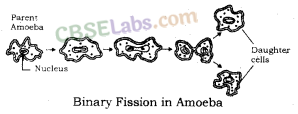
Cytokinesis: Division of cytoplasm.
Karyokinesis: Division of Nucleus.
(ii) Multiple Fission: Seen in Plasmodium, (a malarial parasite). In this during unfavourable conditions, the parent cell develops a thick resistant wall around itself forming a cyst. Within the wall, the cytoplasm divides many times to form many plasmodia. When conditions become favourable, the cyst wall breaks and the Plasmodium are released.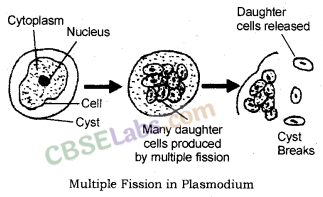
(iii) Budding: Seen in Yeast (a fungus). The parent yeast cell develops a protrusion or an outgrowth at its upper end. The nucleus of the parent cell divides and one of them moves into the outgrowth which grows bigger and finally separates from the parent cell to lead an independent existence. Very often if the conditions are highly favourable, a chain of buds is formed.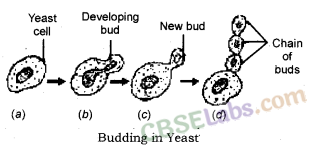
Types of Asexual Reproduction in Multicellular Organisms :
(i) Fragmentation: Seen in multicellular organisms which have a relatively simple body organisation like Spirogyra. Spirogyra has a filamentous body. (If it breaks into smaller pieces or fragments). Each fragment has the capacity to form a new individual.
However, all multicellular organisms cannot show cell-by-cell division as cells from tissues which form organs. These organs are placed at definite positions in the body. Hence, they need to use more complex methods of reproduction.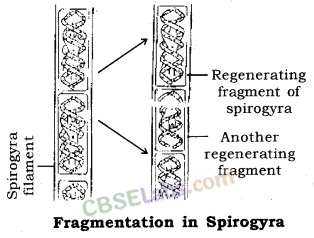
(ii) Regeneration: It is the ability of organisms to develop their lost parts. Some organisms show have high regenerative capacity it is also a means of reproduction for example; Planaria. (Regeneration is carried out by specialized cells which redivide to form a mass of cells from which different cells undergo changes to become different cell types and tissues. These changes occur in an organized sequence known as development).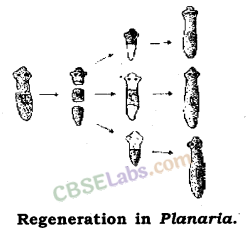
(iii) Budding: Seen in Hydra. Parent Hydra develops a bud at its lower end. This grows in size and finally breaks off to live independently.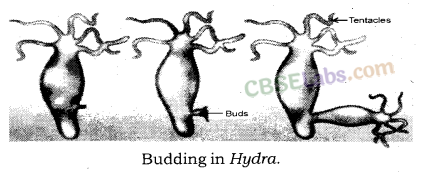
(iv) Spore Formation: Seen in Rhizopus (a fungus). Rhizopus body is made up of thread-like structures called hyphae. The erect hyphae bear sporangia inside which reproductive structures called spores are formed. Spores are asexually reproducing bodies having a thick protective wall. They are produced during unfavourable times and help to tide over the unfavourable environmental conditions. When the spores fall on a suitable medium, each one forms a new individual.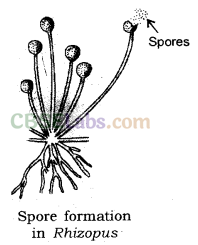
(v) Vegetative Propagation: Method by which plants reproduce by their vegetative parts such as roots, stems, and leaves.
Types of Vegetative Propagation: It is two types
- Natural vegetative propagation.
- Artificial vegetative propagation (Tissue culture).
Mint reproduces naturally by roots. Sugarcane, jasmine by stems and Biyophyllum by leaves. In biyophyllum buds are produced in the notches along the leaf margins and when they fall on the soil, they develop into new plants.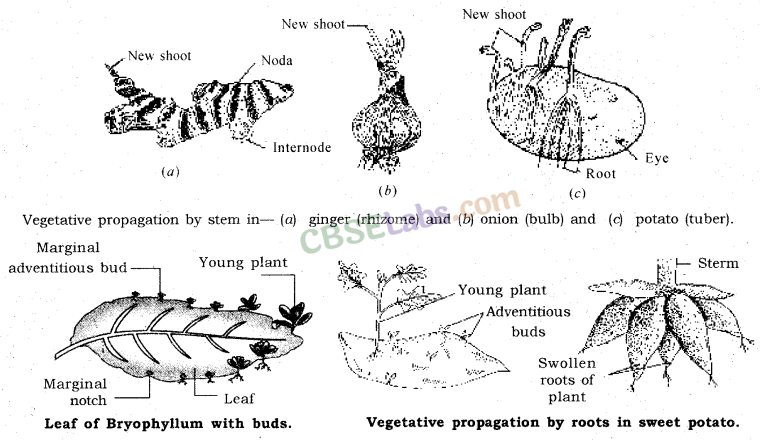
Importance of Vegetative Propagation
- Plants can bear flowers and fruits earlier.
- Plants which have lost the ability to produce viable seeds can also reproduce by vegetative propagation.
- All plants are genetically almost similar to the parent plant.
- Seedless varieties can be obtained.
- The property of vegetative propagation is used by horticulturists in developing methods like layering, grafting to grow many plants like sugarcane, roses, or grapes.
Tissue Culture: The technique of developing new plants from a cell or tissue in a nutrient medium under aseptic conditions. The cell or tissue is placed in a nutrient medium where it forms a mass of cells called callus. This callus is then transferred to another nutrient medium where it differentiates and forms a new plant.
Sexual Reproduction: Sexual reproduction in plants, Sexual reproduction in human beings. The mode of reproduction that takes place with the involvement of two individuals of two different sexes i.e. male and female.
During sexual reproduction, male organism having male sex organs produces male gametes i.e. sperms which are small and motile and the female organism having female sex organs produces ova which are generally large and store food. Male and female gametes fuse to form a zygote that grows into a new organism.
Significance of Sexual Reproduction :
- Sexual reproduction involves DNA as well as cellular apparatus of two different organisms which promotes diversity of characters in the offspring.
- Since gametes are derived from two different organisms, it results in a new combination of genes which increases the chances of genetic variations.
- Sexual reproduction results in the origin of. new species.
- Sexual reproduction involves division in the sex organs that reduces the DNA matter to half so that the zygote formed after fusion has the same amount of DNA as the parents it maintains DNA in a species.
Limitation of Sexual Reproduction: Sexual reproduction involves the process of combining DNA from two different organisms which may bring some undesirable features also.
Sexual reproduction in flowering plants
- The reproductive parts are present in the flower.
- The parts of the flower are sepals, petals, stamens and carpels.
- Sepals are green structures that protect the inner parts when the flower is in bud stage.
- Petals are colourful and attract the insects for pollination.
- Stamens are male reproductive parts and produce pollen grains that contain male gametes. Each stamen has two parts—
- Filament i.e. stalk and Anther i.e. swollen top part which has large number of pollen grains.
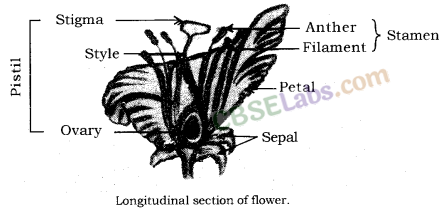
The carpel is the female reproductive part and produces ovules that contain female gametes. It has three parts—Stigma which is top sticky part and receives pollen grains during pollination. Style which is the middle long part and ovary which is the swollen part and contains ovules. Each ovule has an egg cell i.e. female gamete.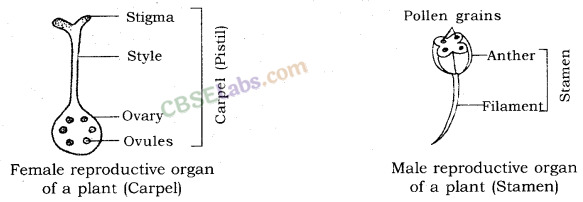
The flowers may be bisexual i.e. having both stamens and carpels for example; Mustard China Rose (Hibiscus).
The flower may be unisexual i.e. paving either stamens or carpels for example; Papaya, Watermelon.
Pollination: The process of transfer of pollen grains from an anther to the stigma of the flower is pollination. Two types of pollination are:
(i) Self-pollination: The transfer of pollen grains from the anther to the stigma of the same flower or another flower of the same plant.
(ii) Cross-pollination: The transfer of pollen grains from the anther to the stigma of another flower or another flower of a different plant of the same species. It generally takes place with the help of some agents like insects, birds, wind and water.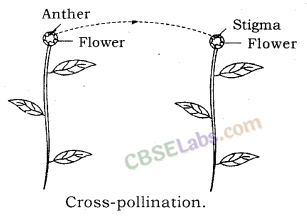
Fertilization: Fertilization is the process of fusion of male and female gamete to form a zygote during sexual reproduction. Pollination is followed by fertilisation in plants. The events are
Pollen grains land on the stigma of the ovary.
Pollen tubes grow out of the pollen grains, travel through the style and reach the ovary, through micro pyle.
Pollen tube has two male germ cells. Each ovule has two polar nuclei and a female germ cell (egg).
Pollen tube releases two male germ cells inside the ovule, one of them fuses with female germ cell and forms a zygote which grows into the baby plant i.e. embryo, the fusion is known as syngamy. The other male germ cell fuses with two polar nuclei, the process is known as triple fusion. So in flowering plants two fusions take place during fertilisation. It is called double fertilisation.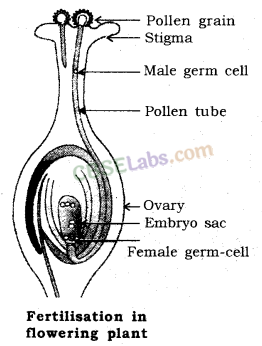
Post-fertilisation changes: After fertilisation the following changes takes place in the flower.
Zygote divides several times and forms an embryo inside the ovule.
- The ovule develops a tough coat and changes into the seed.
- The ovary grows rapidly and ripens to form a fruit.
- Petals, sepals, stamens, style and stigma shrivel and fall off.
Seed and its parts: The advantage of seed is that it protects the future plant i.e. embryo.
Seed has two parts: Cotyledons and Embryo Cotyledons store food for the future plant.
Embryo has two parts: plumule and radicle. Plumule develops into shoot and radicle develops into root.
The process of development of a seedling from the embryo under appropriate conditions is known as germination.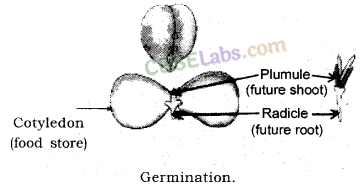
Reproduction in Human Being: Human beings show sexual reproduction. Male parent produces male gametes called sperms. Female parent produces female gametes called ova. Sperms have tail and are therefore, motile. They are produced in large numbers in the testes. Ovum is bigger, non-motile and only one ovary produces one ovum in one month. There is no food stored in the sperms whereas ova contain stored food. Both the gametes are microscopic unicellular and have half the number of chromosomes as compared to the body cells.
Human beings become reproductively active from the onset of puberty. Puberty is the period during adolescence when the rate of general body growth begins to slow down and reproductive tissues begin to mature. Onset of puberty in human males is between 11 to 13 yrs of age, while in human females is between 10 to 12 yrs. of age. Puberty is associated with many physical, mental, emotional and psychological changes in boys and girls which occur slowly over a period of time. These are called secondary sexual characters. For instance thick dark hair start growing in new parts of the body such as arm pits and genital area between the thighs. Thinner hair appear on legs, arms and face. Skin becomes oily and pimples may appear on the face. Individuals become more conscious of their bodies become more independent, more aggressive etc.
In case of boys beard and mustache start appearing, voice begins to crack, reproductive organs develop and start producing releasing sperms.
In case of girls, breast size begins to increase, skin of the nipples darkens, menstruation starts.
The act of mating between the male and female partner is termed as copulation.
Male Reproductive System: Male reproductive system consists of the following components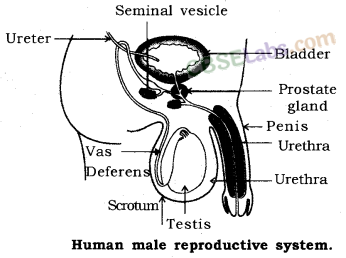
- 1 pair of testes
- A system of ducts
- Epididymis
- Vas deferens or the sperm duct
- Urethra
- A system of glands
- Seminal vesicles
- Prostrate gland
- Cowper’s gland
- A copulatory organ called a penis.
One pair of testes are present in a bag-like structure called scrotum which lies outside the abdominal cavity, hence they are extra abdominal in position. This is so because the testes have to be maintained at 1-3 degree lesser temperature than the body in order to produce functional sperms.
Functions of testes
- To produce male gametes i.e. the sperms.
- To produce a male reproductive hormone called testosterone which is responsible for producing sperms as well as secondary sexual characteristics in males.
Attached to each testis is a highly coiled tube called epididymis. The sperms are stored here and they mature in the epididymis.
Each epididymis leads into the sperm duct or the vas-deferens. Each vas-deferens rises up and enters into the abdominal cavity. It unites with the duct coming from the urinary bladder to form a common duct called urethra which passes through the penis and opens to the outside. Along the way the ducts of the three glands also open and pour their secretions into the vas deferens.
Function of the vas-deferens: It is meant for the passage of the sperms in the male body.
Functions of the glands: They produce different secretions which provide nutrition as well as medium for locomotion to the sperms.
The secretions of the three glands along with the sperms is known as semen.
Function of the urethra: It is the common passage for both semen and urine from the body to. the outside.
Penis: It is the organ which is used to introduce semen into the female body. It is richly supplied with blood vessels.
Female Reproductive System: It consists of the following components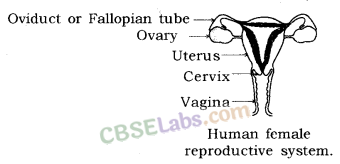
- 1 pair of ovaries
- 1 pair of fallopian tubes or oviducts
- A uterus/womb
- A vagina/birth canal.
Each ovary is almond shaped and present inside the abdominal cavity. At the time of birth each girl child already contains thousands of immature ova. These ova start maturing only from the time of puberty. Only one ovum is produced by one ovary in one month and each ovary releases an ovum in alternate months. The release of an ovum from the ovary into the abdominal cavity is known as ovulation.
Functions of ovary
- To produce and release ova
- To produce female reproductive hormones: estrogen and progesterone.
There are two fallopian tubes. The end lying close to the ovary has finger like structures called fimbriae. The two fallopian tubes unite to form an elastic bag like structure called uterus.
Function of the fallopian tubes: It is the site of fertilization between the male and the female gametes and formation of the zygote early embryo.
The inner lining of the uterus is richly supplied with blood vessels and is known as endometrium. The narrow end of the uterus is called cervix.
Function of the uterus: The embryo formed in the fallopian tube comes down and gets attached to the endometrium (implantation) and develops for the next nine months till the baby is delivered.
Vagina: The uterus opens into the vagina through the cervix. The vagina is a muscular tube through which the baby is delivered at the end of nine months. It also serves as the canal for receiving the semen at the time of copulation.
The semen is discharged into the vaginal tract during copulation. The sperms travel upwards and reach the fallopian tube where one sperm fuses with the ovum to form the zygote. The zygote divides and redivides as it descends into the uterus and the embryo gets implanted in the endometrium. The endometrium thickens so as to receive the embryo.
The embryo gets nutrition from the mother’s blood with the help of a special tissue called placenta, which is a disk-like structure embeded in the uterine wall. It contains finger-like villi on the embryo side, while on the mother’s side blood spaces surround the villi. Villi provides a large surface area for glucose and oxygen to pass from the mother to the developing embryo and the wastes to pass from the embryo to the mother through the placenta. When the embryo starts resembling a human is formed, it is termed as a foetus. The foetus continues
to develop inside the uterus for almost nine months after which the baby is delivered as a result of rhythmic contractions of the uterine muscles.
Menstruation: It is the loss of blood, mucous along with the unfertilized ovum and the ruptured cells and tissues of the endometrium through the vagina of the female. It is a 28-day cycle which occurs in every reproductively active female (from puberty). The flow of blood continues for 2 to 8 days. If the ovum does not get fertilized, then the endometrium starts sloughing off and there is loss of blood and mucous etc. through the vagina. In case the ovum gets fertilized, then the endometrium becomes thick and spongy for nourishing the embryo and hence menstruation does not occur. A lady with a developing embryo in her womb is termed as pregnant. The beginning of menstruation at puberty is known as menarche. The stopage of menstruation when the woman is 45-55 yrs of age is called menopause.
Reproductive Health: Sexually transmitted diseases and birth control.
A number of diseases occur as a result of sexual intercourse if one of the partners is infected. These are known as sexually transmitted diseases (STD’s). They can be caused by bacteria for example; syphilis, gonorrhoea; or caused by a virus for example; HIV-AIDS, warts etc. The transmission of these diseases can be avoided by using birth control measures such as wearing a condom during the sexual act.
Birth control measures: They can be mechanical, chemical and surgical.
Mechanical methods: These are used to prevent the passage of semen to the follopian tube :
(i) Use of condoms: Condoms are thin rubber tubes worn over the penis before sexual intercourse. The semen gets collected in this and is not discharged into the vagina.
(ii) Diaphragm: It is a thin rubber fixed over a flexible metal ring which is fitted over the cervix in a woman’s body by a doctor.
(iii) Intra Uterine Contraceptive Device (IUCD) or loop: It is inserted in the uterus and its insertion causes certain secretion which prevents the implantation of the embryo in the uterine wall.
Both methods (ii) and (iii) cause side effects.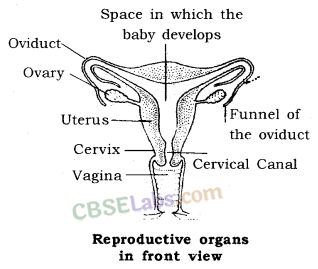
Chemical methods
- Use of spermicides: These are strong sperm-killing chemicals available in the form of creams, jellies etc. which are injected into the vagina just before copulation.
- Oral contraceptive pills: These are hormonal pills which prevent ovulation but do not stop menstruation.
Surgical methods
- Vasectomy: It involves cutting and ligating the vas deferens in males.
- Tubectomy: It involves cutting and ligating Reproductive organs the fallopian tubes in females.
- Medical termination of pregnancy (MTP) or abortions is carried out to eliminate the developing embryo. This practice can, however, be misused to carry out female foeticide which involves the killing of the female foetus. It should be avoided at all cost as it disturbs the male-female ratio in a population.
Reproduction: It is the process by which living organisms produce new individuals similar to themselves.
- Reproduction ensured continuity of life on earth.
- It is a bridge to hereditary transmission.
- It involves a continuation of characters from the parents to daughter cells by copying of DNA (Deoxyribose Nucleic Acid) molecules present in the chromosomes of the cell.
- Copying of DNAs is also not a foolproof exercise, even minute changes bring about variation in the blue print of the offsprings.
- The useful variations are retained while the harmful ones do not go beyond.
- Actually, variations help the species to withstand drastic environmental changes, thus save the species from becoming extinct and promotes its survival for a longer time.
- This inbuilt tendency of variation is the “basis” for Evolution.
Asexual Reproduction: It is extremely useful as a means of rapid multiplication. It is common in lower plants and animals.
Different forms of Asexual Reproduction:
- Fission: The parent cell divides/splits into two daughter cells —Binary fission and splits into many cells —Multiple fission.
- Budding: A new organism is produced as an outgrowth of the parent body part.
- Spore Formation: Spores are small, the bulb-like structure which develops at the top of the erect hyphae of the fungus-plant, when released into the air germinate, into new individuals after landing into food or soil.
- Fragmentation: It is the accidental process when the broken pieces of an organism (fragments) grows into a complete organism. Example, fragmentation in Spirogyra.
- Regeneration: When simple animals like a hydra, planaria develop a new individual from their broken older part it is known as regeneration. It is carried out by specialised cells which grow large numbers of cells.
Vegetative Propagation: A mode of reproduction in which parts like the stem, root, leaves develop into new plants under favourable conditions.
Benefits:
- Plants can bear flowers, fruits more quickly than those produced from seeds.
- Growing banana, orange, rose, jasmine that have lost the capacity to produce seeds.
- The genetical similarity is maintained in the plants. Example, sugarcane, rose, grapes by layering or grafting.
Sexual Reproduction: When reproduction takes place as a result of the fusion between two gametes, one from each parent, it is called sexual reproduction.
- This process of fusion between two gametes is called fertilization.
- The formation of gametes involves an exchange of chromosomal (genetic) fragments between homologous chromosomes causing genetic recombination which leads to variation.
Sexual Reproduction in Plants: It occurs mostly in flowering plants.’ In fact, flowers are the reproductive organ of plants.
- Pollen grains of a flower transfer to the stigma of the carpel of the same flower (Self-Pollination) or to the carpel of another flower (Cross-Pollination).
- This transfer of pollens is achieved by agents like wind, water or animals. After pollination, the pollen grains reach the egg cell in the form of a pollen tube.
- Fertilization. The fusion between the pollen grain and female egg cell. It occurs inside the ovary. The zygote is produced in this process.
- The zygote divides several times to form an embryo within the ovule. The ovule develops a rough coat and is converted into a seed.
- Ovary grows rapidly and ripens to form fruit, while the seed contains the future plant or embryo which develops into a seedling under suitable conditions. This process is known as Germination.
Reproduction in Human Beings:
- Humans use a sexual mode of reproduction.
- It needs sexual maturation which includes the creation of the germ cells, i.e., egg (ova) in the female and sperm in the male partner and this period of sexual maturation is called Puberty.
- Human beings have a well-developed male and female reproductive system.
- The formation of the male germ cell (sperms) takes place in the testes (male reproductive organ). Actually, a pair of testes are located inside scrotum situated outside the abdominal cavity. It is meant to keep a relatively low temperature needed for the production of sperms by testes. Testes release a male sex hormone called testosterone whose function is to:
- regulate the production of sperms;
- brings about changes in appearance seen in boys at the time of puberty; and
- the sperms along with the secretion of the prostate gland and seminal vesicle, together constitute semen, which is released and made to enter into the female genital tract during Copulation.
Female Reproduction System:
- The female germ cells or eggs are made in the ovaries, a pair of which is located in both sides of the abdomen.
- When a girl is bom, the ovaries already contain thousands of immature eggs. At the time of puberty, some of these eggs start maturing. One egg is produced every month by one of the ovaries.
- The egg is carried from the ovary to the womb through a fallopian tube. These two fallopian tubes unite into an elastic bag like structure known as the uterus.
- The uterus opens into the vagina through the cervix.
- Fertilization occurs in the fallopian tube of the female genital tract.
- The fertilized egg also called zygote gets implanted in the lining of the uterus, and starts dividing. The uterus is richly supplied with blood to nourish the growing embryo.
- If the zygote is not formed, the inner wall of uterus breaks which causes bleeding through vagina. This process is called Menstruation. It occurs at a regular interval of 28 days.
- The embryo gets nutrition from the mother’s blood with the help of a special tissue called Placenta.
- Placenta provides a large surface area for glucose and oxygen to pass from the mother to the embryo. Similarly the wastes from developing embryo are removed to mother’s blood through placenta.
- The child is bom as a result of rhythmic contractions of the muscles in the uterus after nine months (36 weeks) of development inside the mother’s womb, called Gestation Period.
- The sexual cycle in a woman continues upto the age of 45 to 50 years. After that the ovaries do not release eggs. This stage is called Menopause. It also marks the end of menstruation in the woman.
Reproductive Health: Reproductive health means total well-being in all aspects of reproduction, z.e., physical, emotional, social and behavioural.
Contraception: It is the avoidance of pregnancy through different methods—Natural methods, Barrier method, Oral contraceptives, Surgical methods.
Advantages of contraception: Help in birth control, prevent sexually transmitted diseases, prevent unwanted pregnancies, keep population explosion in check.
1. Reproduction is the process by which a living organism is able to produce new individuals of its own kind. Unlike other life processes such as nutrition, respiration, etc., it is not essential to, maintain the life of an individual organism. But it is important for the existence and continuity of the species.
2. Reproduction involves the creation of DNA copy and additional cellular apparatus by the cell involved in the process.
3. The process of DNA copying leads to variations. This inbuilt tendency for variations during reproduction is the basis for evolution.
NCERT Solutions for Class 10 Science Chapter 8
4. Living organisms’ reproduce mainly through :
- Asexual reproduction
- Sexual reproduction
5. ASEXUAL REPRODUCTION
(a) Single ceiled organisms reproduce through following ways: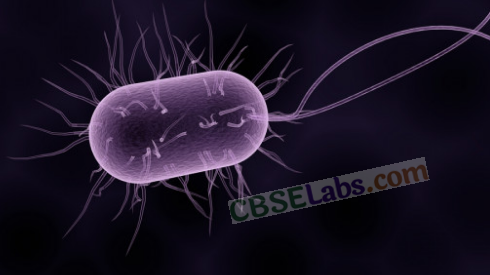
(ii) Budding (also by multicellular organisms)
(iii) Spore formation (also by multicellular organisms)
(b) Asexual reproduction by multicellular organisms:
(i) Fragmentation and Regeneration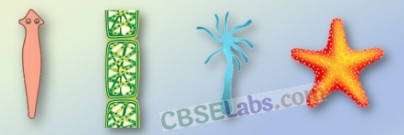
6. Fission: In unicellular organisms when cell becomes fully mature, it splits into two or more parts. It is called the fission. In organisms such as Amoeba, splitting can take place in any plane. But in organisms like Leishmania, having whip like structure at one end of the cell, binary fission occurs in a definite orientation in relation to these structures.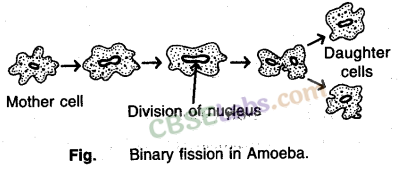
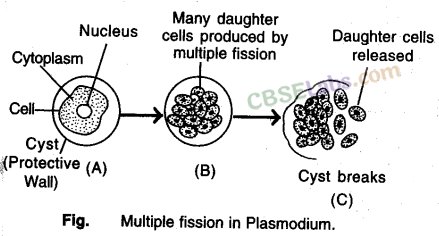
7. Regeneration : It is the ability to give rise to new organism. When the individual is cut or broken up into many pieces. It can be seen in Hydra and Planaria and is known as regeneration.
Regeneration is carried out by specialised cells. These cells proliferate and rqgkeJarge numbers of cells. From this mass of cells, different cells undergo changes to become various cell types and tissues. These changes take place in an organised sequence referred to as ” development. However, regeneration is not the same as reproduction, since most organisms would not normally depend on being cut up to be able to reproduce.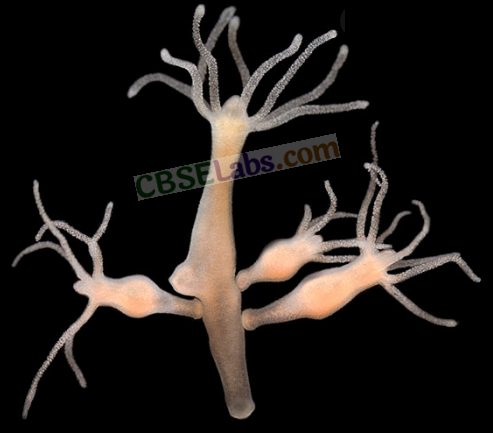
8. Budding: Organisms such as Hydra use regenerative cells for reproduction in the process of budding. In Hydra, a bud develops as an outgrowth due to repeated cell division at one specific site. These buds develop into tiny individuals and when fully mature, detach from the parent body and become new independent individuals.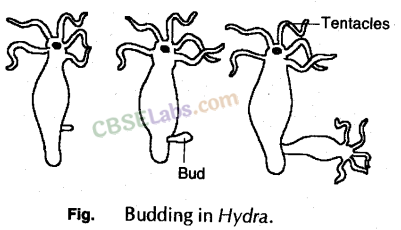
9. Spore Formation (Sporulation): Some bacteria and lower organisms make spores. During spore formation, knob like structure called sporangium develops from the fungal hypha. Sporangia contain spores that eventually develop into new individual. The spores are covered by thick walls that protect them until they come in contact with moist surface or substratum and can begin to grow.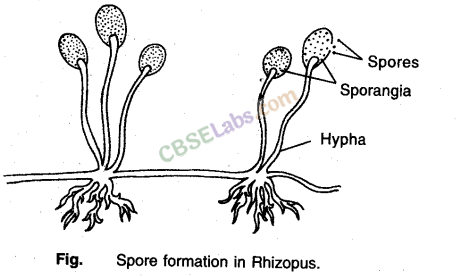
10. Fragmentation : It can be seen in Spirogyra. During this process filament of spirogyra simply breaks up into smaller pieces upon maturation. These pieces or fragments grow into new individuals. This process occurs under favourable conditions of moisture, temperature, light and nutrient availability.
11. Vegetative propagation: It is the simplest method of reproduction in some higher plants in which new plant is produced from any vegetative part of the plant such as root, stem, leaf, etc.
Advantages of vegetative propagation : Vegetative propagation is useful for plants those have lost the capacity to produce seeds, e.g. banana, rose, jasmine. Moreover, all plants produced are genetically similar to the parent plant.
Natural Vegetative Propagation: In some plants like guava, sweet potato, dahlia, roots sprout and grow into new plants during favourable conditions. In some other,stems grow horizontally and develop root below and leaves above the ground. Many other common examples of vegetatively propagating plants are onion, banana, garlic, ginger, turmeric, bryophyllum and water hyacinth.
12. Vegetative propagation in Bryophyllum: Bryophyllum reproduces by the vegetative propagation method. During this method, buds produced in the notches along the leaf margin of bryophyllum fall on the soil and develop into new plants.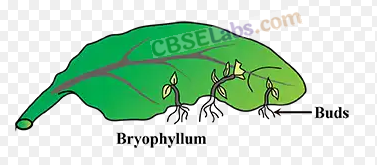
13. SEXUAL REPRODUCTION :
Sexual reproduction involves two individuals for producing a new individual. Sexual reproduction begins with fertilization, which is defined as the union of two different gametes. The motile germ-cell fptrUeh or sperm) is called the male gamete and germ-cell containing stored food (egg or ovum) is called the female gamete. The process of fusion of two gametes is called fertilization. After fertilization, a zygote is formed , which develops into a new organism.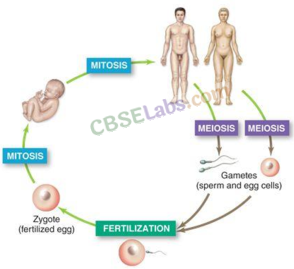
14. Sexual reproduction in Plants : The flowering plants or angiosperms bear special reproductive parts located in the flower. Various parts of flower are; sepals, petals, stamens and carpels.
Most flowers have both male and female reproductive organs. The flower may be unisexual (papaya, watermelon) when it contains either stamen or carpel or bisexual (Hibiscus, Mustard) when it contains both stamens and carpels. It has male reproductive part cal led stamen and a female reproductive part called carpel. Carpel is made of three parts. The swollen bottom part is the ovary, middle elongated part is the style and the terminal part which may be sticky is the stigma.
The ovary contains ovules and each ovule has an egg cell. Each stamen consists of stalk called filament, and a flattened fertile top called anther. The anthers produce the pollen grains. The pollen grains produce male gametes which fuse with (egg cel I) female gamete present in the ovule. This fusion of the germ-cells or fertilization gives zygote which grows into a new plant. Pollination: It is the process of transfer of pollen grains from the anther to the stigma of flower. If this transfer of pollen occurs in the same flower, it is referred to as self-pollination, whereas if the pollen is transferred from one flower to another, it is known as cross-pollination. This transfer is carried out by different agencies like wind, water, insects or animals.
Fertilization: A tube grows out of pollen grain and travels through the style to reach the female germ-cells present in ovule in the ovary. Out of two male gametes present in pollen tube one fuses with egg to form zygote. This fusion is called fertilization. After fertilization, the zygote divides several times to form an embryo within the ovule. The ovule develops a tough coat and gradually turns into a seed. The ovary grows rapidly and ripens to form a fruit. Meanwhile the petals, sepals, stamens, style and stigma may shrivel and fall off.
15. Reproduction in human beings : The reproductive organs of human beings are called gonads. These are testes in male and ovaries in female. The male gonad produces sperms and female gonad produces ova (eggs) at the age of puberty (after attainment of sexual maturity). Various changes occur in girls and boys at this age.
16. Male Reproductive System consists of the following organs:
Testes: A pair of testes are situated in scrotum that lie outside the abdominal cavity and behind the penis. Testes produce sperms and hormone, Testosterone hormone. Testosterone brings about changes in appearance of boys at the time of puberty.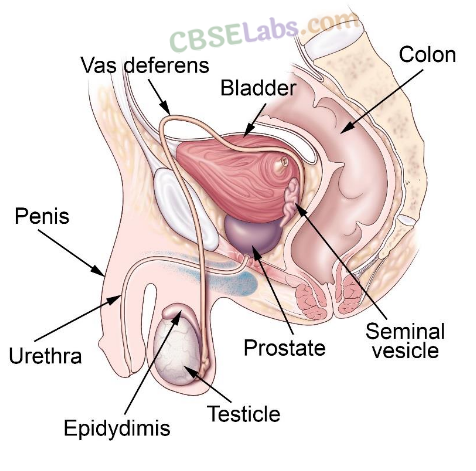
VAS deferens: From each testis, a duct arises which is known as vas deferens which unites with a tube coming from urinary bladder. It brings sperms from testis.
Urethra: Vas deferens tube opens into a common tube called urethra. It runs through a muscular organ called Penis. Penis is male copulatory organ.
Accessory Glands: Glands like prostate and seminal vesicles and Cowper’s gland add their secretions which make transport of sperms easier and this fluid also provides nutrition.
17. Female Reproductive System: It consists of the following organs: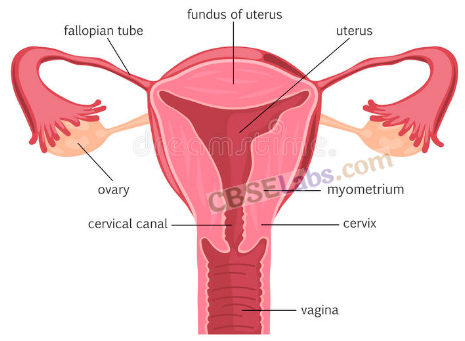
Ovaries: Paired ovaries are located in the abdominal cavity near the kidney. Ovaries produce female gamete (ovum or egg) and secrete female hormones (estrogen and progesterone). One egg is produced every month alternately by one of the ovaries.
Fallopian Tube: The egg is carried from the ovary to womb/uterus through a thin oviduct or fallopian tube.
Uterus: The two oviducts unite into an elastic bag like structure known as the uterus.
Vagina: Uterus opens into the vagina. It is a female copulatory organ.
18. Sexual Cycle in female: After puberty, only one egg is produced alternately from one ovary after a period of 28 days. Egg in fallopian tube encounter sperms which enter through the vaginal passage during sexual intercourse. This fertilized egg (zygote) gets implanted in the lining of uterus which later forms embryo. Embryo gets nutrition from the mother’s blood with the help of special tissue called placenta.
If the egg is not fertilized, if lives for about one day since the ovary releases one egg every month, the uterus prepares itself every month to receive the fertilized egg. Thus, its lining becomes thick and spongy. If it does not get zygote, the developed lining slowly breaks down and comes out through the vagina as blood and mucus. This cycle takes place roughly every month and is known as menstruation. It usually lasts for about 2-5 days.
19. Reproductive Flealth: Reproductive organs need a lot of care and hygiene. Otherwise, they are susceptible to many infections or diseases. The diseases which spread through sexual routes are known as sexually transmitted diseases e.g., bacterial infections like syphilis, gonorrhoea and viral infections such as warts and HIV- AIDS. A condom helps to prevent transmission of many of these infections to some extent.
Frequent pregnancy causes many health problems and also adds to an already exploding population. Many ways have been devised to avoid pregnancy. Contraception can be achieved by:
- Mechanical barrier method (use of condoms).
- Chemical methods (use of pills).
- Use of contraceptive devices (copper-T).
- Surgical methods (vasectomy in males and tubectomy in females)
NCERT Exemplar Class 10 Science Chapter 8 How do Organisms Reproduce?
Short Answer Questions
Question.1 In a bisexual flower, inspite of the young stamens being removed artificially, the flower produces fruit. Provide a suitable explanation for the above situation.
Answer. Removal of stamens of a bisexual flower will not affect pollination of its intact pistil and formation of fruit. Cross-pollination has occurred leading to fertilisation.
Question. 2 Can you consider cell division as a type of reproduction in unicellular organism? Give one reason.
Answer. Yes, because cell division in a unicellular organism results in the formation of two daughter cells which means it produces more individuals of the organisms.
Question.3 Explain how, offspring and parents of organisms reproducing sexually have the same number of chromosomes.
Answer. The parents are diploid (2n) as each of them has two sets of chromosomes. They form haploid (1n) male and female gametes through the process of meiosis. The haploid gametes have one set of chromosomes. Since, these two gametes fuse during fertilisation, the original number of chromosomes is restored in the offspring.
Question. 4 Colonies of yeast fail to multiply in water, but multiply in sugar solution. Give one reason for this.
Answer. Energy is essential for any activity in living organisms. Sugar provides this energy for sustaining all life activities in yeasts. In water, it fails to reproduce because of inadequate energy in its cells. So, colonies of yeast fail to multiply in water but multiply in sugar solution.
Question. 5 Why does bread mould grow profusely on a moist slice of bread rather than on a dry slice of bread?
Answer.Bread mould require moisture and nutrients for its growth. A moist slice of bread contains both moisture and nutrients hence, it grows profusely as compared to a dry slice of bread which contains only nutrients but no moisture.
Question. 6 Give two reasons for the appearance of variations among the progeny formed by sexual reproduction.
Answer.
- In sexual reproduction, two parents have different sets of characters.
- Gene combinations are different in gametes.
Question. 7 In tobacco plant, the male gametes have twenty four chromosomes. What is the number of chromosomes in the female gamete?
What is the number of chromosomes in the zygote?
Answer. The number of chromosomes in the female gamete is 24. The number of chromosomes in the zygote is 48.
Question. 8 Is the chromosome number of zygote,
embryonal cells and adult of a particular organism always constant? How is the constancy maintained in these three stages?
Answer. Yes, the chromosome number of zygote, embryonal cells and adult of a particular organism is always constant.
The constancy is maintained because the cells in all these three structures undergo only mitotic divisions.
Question. 9 How are general growth and sexual v maturation different from each other?
Answer. General growth is the growth of different types of developmental process in the body like increase in height, weight gain, changes in shape and size of the body.
Sexual maturation is a set of changes in body of an individual at puberty like cracking of voice, new hair patterns, development of breast in female, etc.
Question. 10 What would be the ratio of chromosome number between an egg and its zygote? How is the sperm genetically different from the egg?
Answer. The ratio of chromosome number between an egg and its zygote is 1: 2.
Sperm is genetically different from the egg in the way that it contains either X or Y chromosome whereas, an egg always contains an X chromosome.
Long Answer Questions
Question. 11 Distinguish between a gamete and zygote. Explain their roles in sexual reproduction.
Answer.
| Gamete | Zygote |
| (i) It is germ cell that takes part in fertilisation. | (i) It is a product of fertilisation. |
| (ii) There are two types of gametes – male and female. | (ii) Zygote is of one type. |
| (iii) A gamete has haploid or In chromosome number | (iii) Zygote has diploid or 2n chromosome number. |
| (iv) A gamete carries characteristics of only one parent. | (iv) It carries characteristics of both the parents. |
| (v) Gamete is the last cell of its generation. | (v) It is the first cell of new generation. |
Role of Gamete in sexual reproduction — Gamete is the sex or germ cell specialised to take part in sexual reproduction. Fusion of male gamete with a female gamete produces a zygote. Role of Zygote in sexual reproduction — Zygote develops into embryo that later forms the new individual.
Question. 12 What is placenta? Mention its role during pregnancy?
Answer. Placenta is a special tissue that develops between the uterine wall and the embryo (foetus).
The role of placenta during pregnancy is as follows:
- Placenta attaches the foetus to uterine wall.
- It possesses villi that increases the surface area for fixation and absorption.
- It facilitates the passage of nutrition and oxygen to embryo from mother through blood.
- Waste substances produced by embryo (foetus) are removed through placenta into mother’s blood.
Question. 13 How does fertilisation take place? Fertilisation occurs once in a month. Comment.
Answer. Fertilisation takes place in the following ways:
- The sperm enters through the vaginal passage during sexual intercourse and moves upward.
- Egg released from the ovary reaches the oviduct.
- Sperm encounters egg in the oviduct and fertilisation takes place. Fertilisation occurs once in a month because egg is released by female ovary once every month in the middle of menstrual cycle.
Extra Questions – How do Organisms Reproduce – CBSE Class 10 Science
According to new CBSE Exam Pattern, MCQ Questions for Class 10 Science pdf Carries 20 Marks.
Question-1
Name the various types of asexual reproduction.
Solution:
The various types of asexual reproduction are
• Fission – binary and multiple
• Budding
• Spore formation
• Regeneration
• Vegetative propagation – It is a process by which new organisms arise without production of seeds or spores. It can occur naturally or be induced by horticulturists.
Question-2
Differentiate between binary fission and multiple fission.
Solution:
Binary Fission:
1.In this type of fission, the parent cell gives rise to two daughter cells.
2.It is expressed by organisms like amoeba, paramecium, etc.
Multiple Fission:
1.In this type of fission , the parent cell gives rise to more than two daughter cells.
2.It is expressed by organisms plasmodium.
Question-3
List the advantages of vegetative propagation.
Solution:
The advantages of vegetative propagation are as follows
• It helps in the easy propagation of non–flowering plants.
• It helps in producing hybrids of various plants, with improved qualities.
• It helps in the propagation of a large number of populations in a very short duration.
• It helps in the propagation of plants that do not produce seeds or produce them in very small quantities.
Question-4
Name the male and the female gametes in human beings.
Solution:
The male gamete is called sperm and the female gamete is called ovum in human beings.
Question-5
Define fertilization.
Solution:
The process of fusion of the male gamete with the female gamete of the same species, i.e., the sperm with the ovum is known as fertilization. After fertilization, the product obtained is the zygote, which eventually develops into a complete organism.
Question-6
Define sexual reproduction.
Solution:
The type of reproduction that involves both the sexes of the species is known as sexual reproduction. This kind of reproduction requires the fertilization of the gametes of both the sexes.
Question-7
Mention any two functions of human ovary.
Solution:
The two functions of human ovary are as follows
(i) It is responsible for the production of the female gamete, ovum.
(ii) It secretes hormones like estrogen and progesterone.
Question-8
What is syngamy?
Solution:
The process of fusion of the two gametes is known as syngamy. It is the initial step in the process of fertilization.
Question-9
Where does fertilization take place in human females?
Solution:
Fertilization in the case of humans is internal. The process of fertilization takes place inside the fallopian tube of females.
Question-10
Define menopause.
Solution:
At the age of around 45-50 years, the ovaries of the females stop producing ova.
The stoppage of menstrual flow and other events like the changes in the hormonal composition is known as menopause.
Question-11
Discuss briefly the types of reproduction.
Solution:
Reproduction is a unique biological process that is essential for the continuity and propagation of species. It is a process by which new individuals of the same species are produced by parental organisms. It takes place by two methods: –
Asexual Reproduction
This method of reproduction generally involves only one parent and is observed only in lower organisms. Fission, budding, spore formation and vegetative propagation are some of the types of asexual propagation.
Sexual Reproduction
This method of reproduction involves two parents. It requires the fusion of gametes of both the sexes of the species. Almost all animals and higher forms of plants reproduce by this method.
Question-12
Describe asexual reproduction in amoeba.
Solution:
Amoeba reproduces by the process of binary fission. During this process, the nucleus divides first, followed by the formation of a constriction in the cellular membrane of amoeba. This gradually increases inwards and divides the cytoplasm into two parts. Finally two daughter organisms are obtained.
Question-13
Explain various steps of budding in yeast.
Solution:
Budding is a form of asexual reproduction usually observed in yeast.
• During this process, a small protrusion appears on the upper portion of the body of the organism. This bulge is called a bud.
• The bud gradually grows in size and forms an individual cell.
• From this newly budded cell, another bud appears at the tip.
• This process continues and a chain of yeast cells is obtained.
Question-14
What are the various methods of vegetative propagation? Discuss any one method with example.
Solution:
The various types of vegetative propagation are
• Cutting
• Layering
• Grafting
• Parthenogenesis
• Micro-propagation in vitro
Grafting
• It is a method in which two parts of different plants are joined together in such a way that they unite and grow as one plant.
• The portion of the plant that is grafted onto another plant is known as the scion, and the plant on which grafting is performed is known as the stock.
• The stock and the scion are tied in such a way that the cambium of the scion and the stock come in contact with each other.
• The stock is so chosen that it possesses qualities like disease resistance, high water absorbing capacity, deep penetrating roots for a firm hold, etc. The scion is so chosen that it possesses qualities like high yield of pulp or seeds (as desired) from a single fruit, etc.
• For example citrus-root stock is used for a variety of grafts like sweet orange, lime, grape, etc.
Question-15
Define the terms unisexual and bisexual giving examples of each.
Solution:
An animal or an organism, which can be differentiated as male or female.
i.e., The two sexes are present in separate individuals, then such an organism is said to be unisexual.For example, human beings, all mammals. An animal or an organism that possesses both the sexes in a single body is said to be a bisexual animal. For example, earthworm, starfish, etc.
Question-16
Mention the reproductive parts of a flower.
Solution:
The reproductive parts of a flower are as follows
Male reproductive part – Stamens
Female reproductive part – Pistil.
Question-17
What is pollination? Describe cross-pollination.
Solution:
The transfer of pollen grains from anther to stigma is called pollination. Pollen grains are shed from the anther and reach the stigma of either the same flower or a different flower.
Cross-pollination
The transfer of pollen grains from the anther of one flower to the stigma of another flower of the same species is termed as cross-pollination.
Question-18
Describe double fertilization in plants.
Solution:
In the case of plants, the pollen grain releases two male gametes. One fuses with the egg and forms the zygote. The other male gamete fuses with the two polar nuclei. This fusion is said to be triple fusion. Thus, inside an embryo sac, two fusions, syngamy and triple fusion, take place. This mechanism of two fusions occurring in an embryo sac is called double fertilization.
Question-19
What are the male and the female gonads in the human beings? Mention their functions.
Solution:
Testes are the male gonads in human beings. Their functions are
• To produce male hormones like testosterone.
• To produce the male gamete – sperm.
Ovaries are the female gonads in human beings. Their functions are
• To produce female hormones like estrogen and progesterone.
• To produce the female gamete – ovum.
Question-20
Mention the secondary sexual characters in human males and females.
Solution:
The male secondary sexual characters are the growth of hair on the chest, near the genitals, on the face in the form of beard and moustache, development of deep hoarse voice, etc.
The female secondary sexual characters are the development of breasts and mammary glands, axial and pubic hair, etc.
Question-21
Write names of one male and female sex hormones.
Solution:
The names of one male and one female sex hormones are as follows
Male sex hormone – testosterone
Female sex hormone – progesterone.
Question-22
Describe the menstrual cycle.
Solution:
• The commencement of menstruation at puberty is termed menarche and marks the beginning of the reproductive life of a female.
• Initially, inside the ovary, an oogonium or an ovarian follicle is developed into a mature ovum and released into the fallopian tube. This is termed as ovulation.
• After the release, the uterus and the fallopian tubes undergo changes like the thickening of the uterine wall, development of the endometrial lining, etc. to prepare the body for a probable pregnancy.
• If fertilization does not occur, then the thickened inner wall of the uterus breaks down along with its blood vessels and moves out of the vagina in the form of bleeding, called menstrual flow (menstruation).
• It lasts for about 4-7 days.
• This cycle of events taking place in the ovaries and the uterus every 28 days and marked by the menstrual flow is known as the menstrual cycle.
• In a normal healthy woman, ovulation takes place around the 14th day and menstruation occurs every 28 to 30 days.
Question-23
Differentiate between menarche and menopause.
Solution:
• Menarche marks the beginning of the reproductive cycle of a female whereas menopause marks the end of the reproductive cycle.
• Menarche generally takes place at puberty, i.e., at the age of 12-16 years while menopause takes place around the age of 45-50 years.
• After menarche, there is an increased amount of production of female sex hormones whereas after menopause, the secretion of female sex hormones declines and sometimes completely stops.
Question-24
What is ovulation?
Solution:
The ovarian follicles present inside the ovaries develop into mature follicles. Usually, one mature ovarian follicle develops into a mature ovum. It pinches off from the surface of the ovary and enters the fallopian tube. This process is termed as ovulation. Generally ovulation takes place in only one ovary at a time.
Question-25
Write whether the following statements are true or false.
1. Fertilization is the fusion of the sperm and the ovum.
2. Duration of menstrual cycle in human female is 20 days.
3. Onset of menstruation is termed menopause.
4. In human beings, male attains puberty little later than females.
Solution:
1. True
2. False
3. False
4. True.
Question-26
Fertilization is possible if copulation has taken place during the middle of the menstrual cycle.Give reasons.
Solution:
During copulation, a large number of sperms enter the fallopian tube. If copulation takes place during the middle of the menstrual cycle, then fertilization is possible as at this time the ovum would have entered the fallopian tube from the ovary. If copulation takes place before ovulation then fertilization is not possible. Fertilization is marked by the absence of the regular menstrual flow.
Question-27
Mention the methods used for regulation of childbirth.
Solution:
A number of techniques are employed for the regulation of childbirth. They are classified as follows
Barrier methods – Use of physical devices to prevent the entry of sperms inside the female genitals. They include:
1. Condoms
2. Diaphragms
3. Cervical caps
4. Intrauterine contraceptive devices (IUCD) like Copper-T.
Chemical methods – Use of specific drugs by females.
1. Oral pills – Oral contraceptives of mainly hormonal preparations.
2. Vaginal pills
Surgical methods –
1. Vasectomy – Removal or ligation of a small portion of the vas deferens in males.
2. Tubectomy – Removal or ligation of a small portion of fallopian tube in females.
Question-28
Write the full forms of IUCD, AIDS, HIV, and OC.
Solution:
The full forms for the above abbreviations are as follows
IUCD – Intrauterine Contraceptive Devices
AIDS – Acquired Immuno-Deficiency Syndrome
HIV – Human Immuno Virus
OC – Oral Contraceptives.
Question-29
Describe the surgical method of birth control.
Solution:
In the surgical methods of birth control, a small portion of vas deferens in males and the fallopian tube in females is surgically removed or ligated (tied). This process is called Vasectomy in males and Tubectomy in females. As a result of this surgery, gametes cannot be released from the body (in males) and cannot enter the uterus (in females).
Question-30
Define sexually transmitted disease and give two examples.
Solution:
There are certain infectious diseases that spread by sexual contact. Such diseases are called STDs (Sexually Transmitted Diseases). In most cases, the symptoms are burning sensation on urination and urethral discharge. Gonorrhea and Syphilis are the two examples for sexually transmitted diseases. These diseases are curable.
NCERT Solutions for Class 10 Science All Subject NCERT Solutions
- Chapter 1 Chemical Reactions and Equations
- Chapter 2 Acids, Bases and Salts
- Chapter 3 Metals and Non-metals
- Chapter 4 Carbon and Its Compounds
- Chapter 5 Periodic Classification of Elements
- Chapter 6 Life Processes
- Chapter 7 Control and Coordination
- Chapter 8 How do Organisms Reproduce?
- Chapter 9 Heredity and Evolution
- Chapter 10 Light Reflection and Refraction
- Chapter 11 Human Eye and Colourful World
- Chapter 12 Electricity
- Chapter 13 Magnetic Effects of Electric Current
- Chapter 14 Sources of Energy
- Chapter 15 Our Environment
- Chapter 16 Management of Natural Resources
.png)
.png)